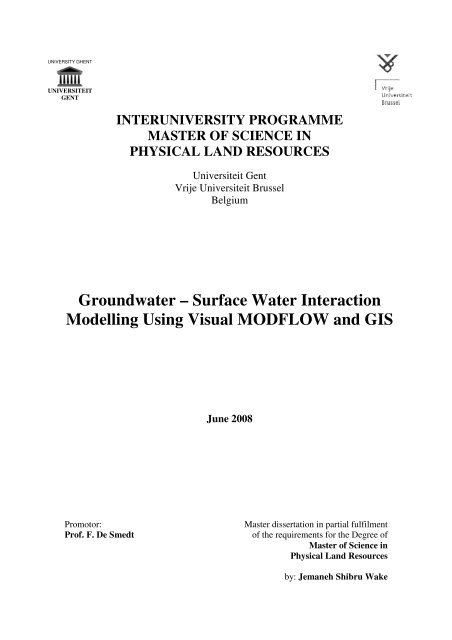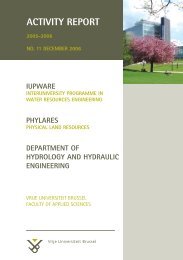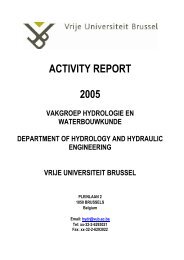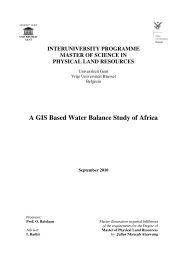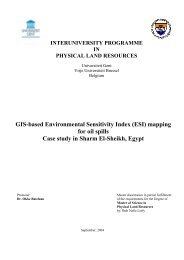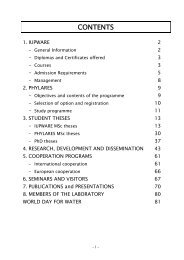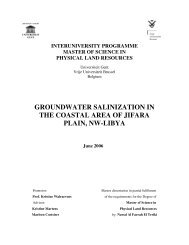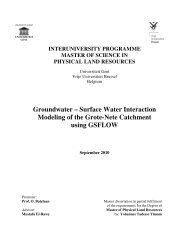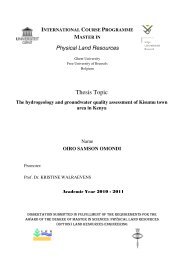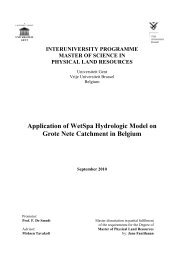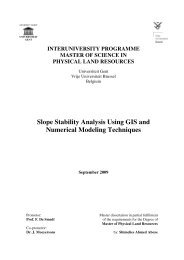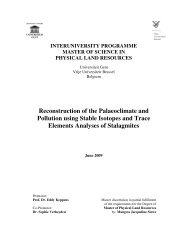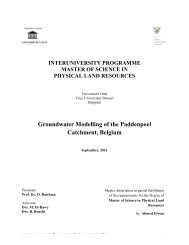Surface Water Interaction Modelling Using Visual MODFLOW and GIS
Surface Water Interaction Modelling Using Visual MODFLOW and GIS
Surface Water Interaction Modelling Using Visual MODFLOW and GIS
- No tags were found...
You also want an ePaper? Increase the reach of your titles
YUMPU automatically turns print PDFs into web optimized ePapers that Google loves.
UNIVERSITY GHENTUNIVERSITEITGENTINTERUNIVERSITY PROGRAMMEMASTER OF SCIENCE INPHYSICAL LAND RESOURCESUniversiteit GentVrije Universiteit BrusselBelgiumGroundwater – <strong>Surface</strong> <strong>Water</strong> <strong>Interaction</strong><strong>Modelling</strong> <strong>Using</strong> <strong>Visual</strong> <strong>MODFLOW</strong> <strong>and</strong> <strong>GIS</strong>June 2008Promotor:Prof. F. De SmedtMaster dissertation in partial fulfilmentof the requirements for the Degree ofMaster of Science inPhysical L<strong>and</strong> Resourcesby: Jemaneh Shibru Wake
PHYLARES__________________________________________________________________________________________IACKNOWLEDGMENTI would like to express my heartfelt gratitude to my brother Y.S. Wake who has had the biggestinfluence in my life in being with me throughout my study in Belgium <strong>and</strong> to support my interestthroughout my stay.I would like to thank my promoter prof. F. De Smedt for his important suggestions. I am equallygrateful to doctoral students, A. Christian <strong>and</strong> G. Adem for their support, guidance, suggestions<strong>and</strong> data provision.I like to thank all my class mates <strong>and</strong> staff members of PHYLARES at Ghent University <strong>and</strong> thedepartment of Hydrology <strong>and</strong> Hydraulic engineering of the Free University of Brussels for theirsupport <strong>and</strong> services.______________________________________________________________________________________Groundwater – <strong>Surface</strong> water interaction modeling using visual <strong>MODFLOW</strong> <strong>and</strong> <strong>GIS</strong>
PHYLARES__________________________________________________________________________________________IIAbstractUnderst<strong>and</strong>ing interconnections among the components of the hydrologic cycle is fundamental todevelopment of effective water resources management <strong>and</strong> policy. The need to assess the effectsof variability in geology, climate, biota <strong>and</strong> human activities on water availability <strong>and</strong> flowrequires the development of models that couple two or more components of the hydrologic cycle.Groundwater <strong>and</strong> surface water resources are by no means disjoint, as knowing where surfacewater recharges groundwater <strong>and</strong> where groundwater flows supply surface water is an importantaspect of the hydrologic cycle. As global concerns over water resources <strong>and</strong> the environmentincrease, the importance of considering groundwater <strong>and</strong> surface water as a single resource hasbecome increasingly evident.Ground water <strong>and</strong> surface water are hydraulically interconnected, but the interactions aredifficult to observe <strong>and</strong> measure. In many situations, surface-water bodies gain water <strong>and</strong> solutesfrom ground-water systems <strong>and</strong> in others the surface-water body is a source of ground-waterrecharge <strong>and</strong> causes changes in ground-water quality. As a result, withdrawal of water fromstreams can deplete ground water or conversely, pumpage of ground water can deplete water instreams, lakes, or wetl<strong>and</strong>s. Pollution of surface water can cause degradation of ground-waterquality <strong>and</strong> conversely pollution of ground water can degrade surface water. Thus, effective l<strong>and</strong><strong>and</strong> water management requires a clear underst<strong>and</strong>ing of the linkages between ground water <strong>and</strong>surface water as it applies to any given hydrologic setting.At some reaches water moves from the l<strong>and</strong> surface to the subsurface <strong>and</strong> in other areas it movesfrom the subsurface to the l<strong>and</strong>. Lakes <strong>and</strong> wetl<strong>and</strong>s can receive groundwater inflow throughouttheir entire bed, have outflow throughout their entire bed, or have both inflow <strong>and</strong> outflow atdifferent localities. In this thesis, surface water <strong>and</strong> groundwater interaction model wasdeveloped for a study area located in the Nete Catchment, Belgium.______________________________________________________________________________________Groundwater – <strong>Surface</strong> water interaction modeling using visual <strong>MODFLOW</strong> <strong>and</strong> <strong>GIS</strong>
PHYLARES__________________________________________________________________________________________Table of contentsAcknowledgment ............................................................................................................................ IAbstract .......................................................................................................................................... IITable of contents ......................................................................................................................... IIIList of figures ................................................................................................................................ VList of tables................................................................................................................................. VIChapter 1:Introduction ................................................................................................................ 11.1 General Overview ....................................................................................................... 11.2 Objective ..................................................................................................................... 21.3 Structure of the thesis.................................................................................................. 3Chapter 2:Approach <strong>and</strong> Methodology ...................................................................................... 42.1 General overview of Models ....................................................................................... 42.2 Groundwater models ................................................................................................... 52.3 Model Development.................................................................................................... 72.3.1 Model Objectives ................................................................................................... 72.3.2 Hydrogeological Characterization ......................................................................... 72.3.3 Model Conceptualization ....................................................................................... 72.3.4 Model Design ......................................................................................................... 72.3.5 Model Calibration .................................................................................................. 82.3.6 Sensitivity Analysis ............................................................................................... 82.3.7 Model Verification ................................................................................................. 82.3.8 Predictive Simulations ........................................................................................... 82.3.9 Performance monitoring Plan ................................................................................ 92.4 Methodology ............................................................................................................... 9Chapter 3:<strong>Interaction</strong> of groundwater <strong>and</strong> surface water ...................................................... 103.1 General overview ...................................................................................................... 103.2 <strong>Interaction</strong> of groundwater <strong>and</strong> stream ..................................................................... 123.3. <strong>Interaction</strong> of Groundwater <strong>and</strong> Lakes ..................................................................... 173.4 <strong>Interaction</strong> of Groundwater <strong>and</strong> Wetl<strong>and</strong>s ................................................................ 173.5 Groundwater <strong>and</strong> Coastal Environments ................................................................. 183.6. Human activity <strong>and</strong> interaction of groundwater <strong>and</strong> surface water .......................... 18Chapter 4:Description of the study area ................................................................................... 194.1 Geographical location ............................................................................................... 194.2 Study boundaries <strong>and</strong> previous work ....................................................................... 204.3 Topography .............................................................................................................. 224.4 Hydrological setting ................................................................................................. 244.5 Recharge .................................................................................................................. 254.6 L<strong>and</strong>-use <strong>and</strong> Soil .................................................................................................... 254.7 Climate of the study area ......................................................................................... 25Chapter 5:Modeling tools ........................................................................................................... 275.1 ArcView <strong>GIS</strong> ............................................................................................................ 275.1.1 Introduction ........................................................................................................... 275.1.2 Types of data used in ArcView <strong>GIS</strong> ..................................................................... 275.1.3 Geographical data ................................................................................................. 275.1.4 Spatial data ............................................................................................................ 28III______________________________________________________________________________________Groundwater – <strong>Surface</strong> water interaction modeling using visual <strong>MODFLOW</strong> <strong>and</strong> <strong>GIS</strong>
PHYLARES__________________________________________________________________________________________5.1.5 Image data ............................................................................................................. 285.1.6 Tabular data .......................................................................................................... 285.1.7. Extensions of <strong>GIS</strong> ................................................................................................. 285.2 <strong>Visual</strong> <strong>MODFLOW</strong> .................................................................................................. 295.3. Surfer 8...................................................................................................................... 305.4 Grapher 7 .................................................................................................................. 30Chapter 6:Model Setup .............................................................................................................. 316.1 Description of the Groundwater Flow Model ........................................................... 316.1.1 Model dimensions ................................................................................................ 326.1.2 Layers ................................................................................................................... 336.1.3 Elevation limits .................................................................................................... 346.1.4 Grid ...................................................................................................................... 346.1.5 Elevation data....................................................................................................... 346.1.6 Hydrogeological information ............................................................................... 366.1.7 Aquifer characteristics data.................................................................................. 386.1.8. Hydraulic conductivity......................................................................................... 416.1.9 River ..................................................................................................................... 416.2 Input to the model ..................................................................................................... 426.2.1 Recharge ............................................................................................................... 426.2.2 River ...................................................................................................................... 436.2.3 Constant Head boundary ....................................................................................... 446.3 Output from the model .............................................................................................. 44Chapter 7:Model calibration ..................................................................................................... 467.1 Calibration water levels ........................................................................................... 477.2 Calibrated Aquifer Parameters ................................................................................. 497.2.1 Hydraulic conductivity.......................................................................................... 497.2.2 <strong>Water</strong> levels .......................................................................................................... 49Chapter 8:Results <strong>and</strong> discussion .............................................................................................. 528.1 Output from the model .............................................................................................. 528.1.1 Model <strong>Water</strong> balance ............................................................................................ 528.1.2. Zonebudget ........................................................................................................... 558.3 Groundwater head ..................................................................................................... 568.3 Groundwater - <strong>Surface</strong> <strong>Water</strong> <strong>Interaction</strong>s ............................................................... 58Chapter 9:Conclusions <strong>and</strong> Recommendations ....................................................................... 639.1 Conclusions ............................................................................................................... 639.2. Recommendations <strong>and</strong> future considerations ........................................................... 64References .................................................................................................................................... 65Annex ........................................................................................................................................... 68IV______________________________________________________________________________________Groundwater – <strong>Surface</strong> water interaction modeling using visual <strong>MODFLOW</strong> <strong>and</strong> <strong>GIS</strong>
PHYLARES__________________________________________________________________________________________VList of figuresFigure 3.1 Flow through a Hypothetical aquifer system ........................................................ 11Figure 3. 2 <strong>Interaction</strong> of streams <strong>and</strong> ground water. .............................................................. 13Figure 3. 3 Effects of pumping from a hypothetical aquifer discharging to a stream ............ 15Figure 3. 4 The dynamic interface between ground water <strong>and</strong> streams. ................................. 16Figure 4. 1 Geographical Location of Belgium ...................................................................... 19Figure 4. 2 The study area <strong>and</strong> its location in the Nete Basin. ................................................ 21Figure 4. 3 Two – dimensional view <strong>and</strong> elevation of the study area. .................................... 22Figure 4. 4 3D of Topography ................................................................................................. 24Figure 4. 5 Slope map of the study area .................................................................................. 24Figure 6. 1 Model domain <strong>and</strong> units of measurement. ............................................................ 33Figure 6. 2 Bottom elevation for layer 1 ................................................................................. 35Figure 6. 3 Bottom elevation of layer 2 ................................................................................... 35Figure 6. 4 Bottom elevation of layer 3 ................................................................................... 36Figure 6. 5 Stratigraphy of the different aquifer units of the model. ...................................... 38Figure 6. 6 Geologic cross – section along the middle points of the model. .......................... 39Figure 6. 7 Geologic cross – section along the river flow route ............................................. 40Figure 6. 8 Two- dimensional view of the river segment in the model domain. .................... 41Figure 6. 9 Spatially distributed recharge ............................................................................... 42Figure 6. 10 Reclassified recharge zones <strong>and</strong> their values ....................................................... 43Figure 6. 11 Head values of layer 1 used for constant head boundary. .................................... 44Figure 6. 12 Location of the pumping wells ............................................................................. 45Figure 7. 1 Location of observation wells ............................................................................... 48Figure 7. 2 simulated versus field measured water levels ....................................................... 50Figure 7. 3 Scattergram for the measured versus simulated values ........................................ 51Figure 8. 1 The Volumetric water balance of the model. ........................................................ 53Figure8. 2 Volumetric water balance of the model in percentage of components. ................ 54Figure 8. 2 Zone 2 water balance ............................................................................................ 55Figure 8. 3 Ground water heads <strong>and</strong> flow directions in Layer 1 ............................................. 56Figure 8. 4 Equipotential head distribution of layer 2 ............................................................. 57Figure 8. 5 Equipotential head for layer 3 ............................................................................... 58Figure 8. 6 Cross section along column 328, groundwater flows to the river ......................... 59Figure 8. 7 Cross- section along row 185. Groundwater flows away from the river .............. 60Figure 8. 8 Position of the river water level <strong>and</strong> the groundwater level ................................ 61Figure 8. 9 North- South water table cross section along column 222. .................................. 62Figure 8. 10 General flow direction of groundwater within the model domain ........................ 62______________________________________________________________________________________Groundwater – <strong>Surface</strong> water interaction modeling using visual <strong>MODFLOW</strong> <strong>and</strong> <strong>GIS</strong>
PHYLARESIntroduction / ch.1__________________________________________________________________________________________1Chapter 1Introduction1.1 General Overview<strong>Water</strong> covers two-thirds of the Earth’s surface <strong>and</strong> surrounds the planet in vapor form. Chemical<strong>and</strong> density stratification during <strong>and</strong> immediately following accretionary heating of the Earth’sprimordial planetary body resulted in its present layered configuration. Internal heat <strong>and</strong>chemical reactions caused water, which was originally bound as oxygen <strong>and</strong> hydroxide inminerals, to diffuse from the Earth’s interior towards its surface. This degassing (still an ongoingprocess) of both water <strong>and</strong> other volatile species resulted in the accumulation <strong>and</strong> eventualcondensation of the fluid envelope of the Earth. Of course, water was also delivered to our planetby infalling comets <strong>and</strong> other H 2 O bearing planetesimals.The hydrologic cycle describes the complex system whereby water circulates among its variousreservoirs at <strong>and</strong> near the surface of the Earth. These reservoirs include the oceans, theatmosphere, underground water (including both soil water <strong>and</strong> groundwater), surface water(lakes, rivers <strong>and</strong> wetl<strong>and</strong>s), glaciers <strong>and</strong> the polar ice caps. The Hydrologic cycle is directlycoupled to the Earth’s energy cycle, because solar radiation combines with gravity to drive theglobal circulation of water. This circulation, in turn, plays an important role in the heat balanceof the Earth’s surface. The hydrologic cycle is also closely linked to the geosphere <strong>and</strong> its rockcycle. <strong>Water</strong> erodes geologic materials, <strong>and</strong> the breakdown of these materials releases manychemical constituents that in turn define the chemical nature of the water. <strong>Water</strong> can also buildgeologic formations, through both chemical <strong>and</strong> mechanical depositional processes. <strong>Water</strong> isessential to all life forms in the planetary biosphere. (Mauricie, et.al, 2001).Only a small portion (3 %) of the water covering the earth’s surface is fresh. Of the fresh water77.5% is locked in ice fields <strong>and</strong> glaciers. <strong>Surface</strong> water <strong>and</strong> underground water are the utilizable______________________________________________________________________________________Groundwater – <strong>Surface</strong> water interaction modeling using visual <strong>MODFLOW</strong> <strong>and</strong> <strong>GIS</strong>
PHYLARESIntroduction / ch.1__________________________________________________________________________________________2fresh water resources of which groundwater water accounts for 95%; lakes, reservoirs, swamps<strong>and</strong> river channels 3.5%; <strong>and</strong> soil moisture comprises 1.5% (Freeze & Cherry, 1979).Underst<strong>and</strong>ing interconnections among the components of the hydrologic cycle is fundamental todevelopment of effective water resources management <strong>and</strong> policy. Ground water <strong>and</strong> surfacewater are hydraulically interconnected, but the interactions are difficult to observe <strong>and</strong> measure.In many situations, surface-water bodies gain water <strong>and</strong> solutes from ground-water systems <strong>and</strong>in others the surface-water body is a source of ground-water recharge <strong>and</strong> causes changes inground-water quality. As a result, withdrawal of water from streams can deplete ground water orconversely, pumpage of ground water can deplete water in streams, lakes, or wetl<strong>and</strong>s. Pollutionof surface water can cause degradation of ground-water quality <strong>and</strong> conversely pollution ofground water can degrade surface water. Thus, effective l<strong>and</strong> <strong>and</strong> water management requires aclear underst<strong>and</strong>ing of the linkages between ground water <strong>and</strong> surface water as it applies to anygiven hydrologic setting.In this work <strong>Visual</strong> <strong>MODFLOW</strong> 3.0 groundwater modeling package is utilized to quantifygroundwater – surface water interaction. <strong>Visual</strong> <strong>MODFLOW</strong> 3.0 package is an integratedmodeling environment for applications in three – dimensional groundwater flow <strong>and</strong>contaminant transport simulations based on the finite-difference method.ArcView <strong>GIS</strong> has been used to store analyze <strong>and</strong> display the spatial data on topography, recharge,<strong>and</strong> in making the base map for the visual <strong>MODFLOW</strong>. Thus visual <strong>MODFLOW</strong> <strong>and</strong> ArcView<strong>GIS</strong> have been used to simulate the ground water flow <strong>and</strong> consequently the flux between theground water <strong>and</strong> surface water.1.2 ObjectiveThe main objectives of this thesis work are to:• Develop a steady – state model <strong>and</strong> calculate the water balance of the area• Quantify the flux exchange between the ground water <strong>and</strong> the river in the study area( groundwater – surface water interaction)• Identify the loosing <strong>and</strong> gaining sections of the river______________________________________________________________________________________Groundwater – <strong>Surface</strong> water interaction modeling using visual <strong>MODFLOW</strong> <strong>and</strong> <strong>GIS</strong>
PHYLARESIntroduction / ch.1__________________________________________________________________________________________3Specific objectives of this thesis are:• Calibration <strong>and</strong> validation of the model• Development of a model to simulate groundwater flow in the study area <strong>and</strong> interpret theflow system using the developed model.1.3 Structure of the thesisThis thesis is organized into three major parts: literature review, methodology <strong>and</strong> discussion ofthe results <strong>and</strong> conclusion & recommendations. Chapter 1 is the introductory part which dealsmainly with the importance of the topic <strong>and</strong> the associated research questions. Chapters 2 <strong>and</strong> 3deal with literature review on past <strong>and</strong> existing knowledge about the topic of groundwatersurfacewater interaction <strong>and</strong> its importance in the study of hydrologic systems. Chapter 4focuses on the detailed description of the study area <strong>and</strong> available data for the modeling work.Chapter 5 – 8 discuss the modeling tools, procedure, calibration of the model <strong>and</strong> the resultsobtained. Conclusion <strong>and</strong> recommendation is presented in Chapter 9 on the ideas <strong>and</strong> issues forfurther work in the focus area.______________________________________________________________________________________Groundwater – <strong>Surface</strong> water interaction modeling using visual <strong>MODFLOW</strong> <strong>and</strong> <strong>GIS</strong>
PHYLARESApproach <strong>and</strong> methodology / ch.2__________________________________________________________________________________________4Chapter 2Approach <strong>and</strong> Methodology2.1 General overview of ModelsModels are a substitute for a real system. Models are used when it is easier to work with asubstitute than with the actual system. Domenico (1972) defined a model as a representation ofreality that attempts to explain the behavior of some aspect of it <strong>and</strong> is always less complex thanthe system it represents. Wang & Anderson (1982) defined a model as a tool designed torepresent a simplified version of reality. Banks (1993) defines two types of models (1)consolidative: Consolidates facts regarding the system into a single model used as a surrogate tothe real system <strong>and</strong> (2) exploratory: a series of computational experiments to explore cause <strong>and</strong>effect. Bredehoft et.al. Further subdivided ground water models into (1) Data driven exploratorymodels or “history matching” (2) policy question driven models <strong>and</strong> (3) conceptually drivenmodels.In studying a groundwater flow model we first develop a conceptual model descriptive of thepresent condition of a system. At this stage we identify relevant processes <strong>and</strong> physical elementscontrolling groundwater flow in the aquifer, namely: the Geologic framework, the Hydrologicframework, the Hydraulic properties, <strong>and</strong> the Sources & sinks (water budget) <strong>and</strong> determine datadeficiencies. Conceptual model dictates how we translate the real world to a mathematical Model.To make predictions of future behavior, a dynamic model is needed that is capable ofmanipulation. Mathematical models are one type of dynamic models <strong>and</strong> use equations torepresent the interconnections in a system. The simplest mathematical model of groundwaterflow is Darcy’s law. To apply Darcy’s law we need to have a conceptual model of the aquifer<strong>and</strong> to develop data on the physical properties of the aquifer system, the potential field <strong>and</strong> thefluid properties. The process of formulating <strong>and</strong> solving a mathematical model is referred to asmathematical modeling. The methods of obtaining the solution to a mathematical model can be______________________________________________________________________________________Groundwater – <strong>Surface</strong> water interaction modeling using visual <strong>MODFLOW</strong> <strong>and</strong> <strong>GIS</strong>
PHYLARESApproach <strong>and</strong> methodology / ch.2__________________________________________________________________________________________5broadly divided into two classes, analytical <strong>and</strong> numerical, even though the hybrid of these twoclasses is not uncommon. Analytical methods yield exact solutions to the governing differentialequations. Darcy’s law is an example of an analytical model. To solve an analytical model, onemust know the initial <strong>and</strong> boundary conditions of the flow problem. These conditions must besimple enough that the flow equation can be solved directly by using calculus.Numerical methods approximate the differential equations with a set of algebraic equations.These recast equations are numerical approximations <strong>and</strong> the answers obtained are alsoapproximations. The equations are most commonly in matrix form <strong>and</strong> they are solved on adigital computer, unlike analytical models which can be solved rapidly, accurately <strong>and</strong>inexpensively with a programmable calculator or a spread sheet on a personal computer.Generally, analytical solutions can be obtained under many simplifying assumptions, such as aunidirectional velocity field, a set of uniform transport properties, a simple flow domaingeometry, <strong>and</strong> a simple pattern of sink <strong>and</strong> source distribution. For this reasons, numericalsolutions which are capable of approximating more general conditions, are more widely used infield applications (Zheng & Bennett, 2002). This thesis is a numerical model to approximatesteady state water balance <strong>and</strong> interaction of surface <strong>and</strong> groundwater.2.2 Groundwater modelsGroundwater models are computer programs of groundwater flow systems for the calculation ofgroundwater flux <strong>and</strong> head. Because of the simplifying assumptions embedded in themathematical equations <strong>and</strong> the many uncertainties in the values of data required by the model, amodel must be viewed as an approximation <strong>and</strong> not an exact duplication of field conditions.Groundwater models, however, even as approximations are a useful investigation tool.For the calculations one needs (hydrological) inputs, (hydraulic) parameters, initial <strong>and</strong> boundaryconditions.The input is usually the inflow into the aquifer or the recharge, which variestemporally <strong>and</strong> spatially.Important parameters are the topography, thicknesses of soil <strong>and</strong> aquifer layers <strong>and</strong> theirhorizontal <strong>and</strong> vertical hydraulic condustivity, porosity <strong>and</strong> storage coefficient, capillarity of the______________________________________________________________________________________Groundwater – <strong>Surface</strong> water interaction modeling using visual <strong>MODFLOW</strong> <strong>and</strong> <strong>GIS</strong>
PHYLARESApproach <strong>and</strong> methodology / ch.2__________________________________________________________________________________________6unsaturated zone.Initial conditions <strong>and</strong> boundary conditions can be related to levels, pressures,<strong>and</strong> hydraulic heads on the one h<strong>and</strong> (head conditions), or to recharge, discharge, inflow <strong>and</strong>outflow on the other h<strong>and</strong> (flow conditions).In general, groundwater models are conceptual descriptions or approximations that describe thegiven flow system using mathematical equations; they are an approximate descriptions of thephysical system or process. By mathematically representing a simplified version of ahydrogeological system, reasonable alternative scenarios can be predicted, tested, <strong>and</strong> compared.The applicability or usefulness of a model depends on how closely the mathematical equationsapproximate the physical system being modeled (model calibration).Application of existing groundwater models include water balance (in terms of water quantity),assessing the impact of changes of the groundwater regime on the environment, settingup/optimizing monitoring networks, setting up groundwater protection zones <strong>and</strong> underst<strong>and</strong>ingthe quantitative aspects of the unsaturated zone, simulating water flow <strong>and</strong> chemical migration inthe saturated zone including groundwater – <strong>Surface</strong> water interactions.Groundwater modeling begins with a conceptual underst<strong>and</strong>ing of the physical problem. Thenext step in modeling is translating the physical system into mathematical terms. Most modelssolve the general form of the three-dimensional groundwater flow equation which is acombination of the water balance equation <strong>and</strong> Darcy’s law:∂ ⎛ ∂h⎞⎜ Kx ⎟ +∂x⎝ ∂x⎠⎛ ∂h⎞⎜ Kyy ⎝ ∂y∂∂⎟ +⎠∂ ⎛ ∂h⎞⎜ Kz ⎟ ± W∂z⎝ ∂z⎠∂h= Ss∂t(1)Where,Kx, Ky, Kz are hydraulic conductivity values along the x, y, z axes [LT -1 ]h = hydraulic head [L]W = source/sink terms [T -1 ]Ss = specific storage coefficient [L -1 ]t is time [T].______________________________________________________________________________________Groundwater – <strong>Surface</strong> water interaction modeling using visual <strong>MODFLOW</strong> <strong>and</strong> <strong>GIS</strong>
PHYLARESApproach <strong>and</strong> methodology / ch.2__________________________________________________________________________________________72.3 Model DevelopmentA groundwater model application can be considered to be two distinct processes. The firstprocess is model development resulting in a software product, <strong>and</strong> the second process isapplication of that product for a specific purpose.2.3.1 Model ObjectivesModel objectives should be defined which explain the purpose of using a groundwater model.The modeling objectives will profoundly impact the modeling effort required.2.3.2 Hydrogeological CharacterizationProper characterization of the hydrogeological conditions at a site is necessary in order tounderst<strong>and</strong> the importance of relevant flow or solute transport processes. Without proper sitecharacterization, it is not possible to select an appropriate model or develop a reliably calibratedmodel.2.3.3 Model ConceptualizationModel conceptualization is the process in which data describing field conditions are assembledin a systematic way to describe groundwater flow <strong>and</strong> contaminant transport processes at a site.The model conceptualization aids in determining the modeling approach <strong>and</strong> which modelsoftware to use.2.3.4 Model DesignTo successfully transform a conceptual model into a mathematical model, it is necessary to havea database that provides adequate information to apply the requisite equations. All models startwith a groundwater flow model. For this, one needs to know the physical configuration of theaquifer. This includes the location, areal extent, <strong>and</strong> thickness of all the aquifers <strong>and</strong> confininglayers; the location of the surface water bodies <strong>and</strong> streams; <strong>and</strong> the boundary conditions of allaquifers.Important hydraulic properties include the variation of transmissivity or permeability <strong>and</strong> storagecoefficient of the aquifers, the variations of permeability <strong>and</strong> specific storage of the confining______________________________________________________________________________________Groundwater – <strong>Surface</strong> water interaction modeling using visual <strong>MODFLOW</strong> <strong>and</strong> <strong>GIS</strong>
PHYLARESApproach <strong>and</strong> methodology / ch.2__________________________________________________________________________________________8layers, <strong>and</strong> the hydraulic connection between the aquifer <strong>and</strong> surface- water bodies. Hydraulicenergy as indicated by the water table or potentiometric surface maps <strong>and</strong> the amounts of naturalaquifer recharge <strong>and</strong> natural stream flow are also needed. (Fetter, 2001).To model stresses on thenatural ground-water flow system, the modeler must know the locations, types, <strong>and</strong> amounts,through time, of any artificial recharge, such as results from recharge basins <strong>and</strong> wells or returnflow from irrigation, as well as the amounts <strong>and</strong> locations through time of ground-waterwithdrawals from wells. Changes in the amounts of water flowing in the streams <strong>and</strong> changes inthe water levels of surface-water bodies should also be known.2.3.5 Model CalibrationModel calibration consists of changing values of model input parameters in an attempt to matchfield conditions within some acceptable criteria. Model calibration requires that field conditionsat a site be properly characterized. Lack of proper site characterization may result in a modelcalibrated to a set of conditions that are not representative of actual field conditions.2.3.6 Sensitivity AnalysisA sensitivity analysis is the process of varying model input parameters over a reasonable range(range of uncertainty in value of model parameter) <strong>and</strong> observing the relative change in modelresponse. Typically, the observed change in hydraulic head, flow rate or contaminant transportare noted. Data for which the model is relatively sensitive would require future characterization,as opposed to data for which the model is relatively insensitive.2.3.7 Model VerificationA calibrated model uses selected values of hydrogeologic parameters, sources <strong>and</strong> sinks <strong>and</strong>boundary conditions to match historical field conditions. The process of model verification mayresult in further calibration or refinement of the model. After the model has successfullyreproduced measured changes in field conditions, it is ready for predictive simulations.2.3.8 Predictive SimulationsA model may be used to predict some future groundwater flow or contaminant transportcondition. The model may also be used to evaluate different remediation alternatives. However,______________________________________________________________________________________Groundwater – <strong>Surface</strong> water interaction modeling using visual <strong>MODFLOW</strong> <strong>and</strong> <strong>GIS</strong>
PHYLARESApproach <strong>and</strong> methodology / ch.2__________________________________________________________________________________________9errors <strong>and</strong> uncertainties in a groundwater flow analysis <strong>and</strong> solute transport analysis make anymodel prediction no better than an approximation. For this reason, all model predictions shouldbe expressed as a range of possible outcomes that reflect the assumptions involved <strong>and</strong>uncertainty in model input data <strong>and</strong> parameter values.2.3.9 Performance monitoring PlanGroundwater models can be used to predict the migration pathway <strong>and</strong> concentrations ofcontaminants in groundwater. Errors in the predictive model, even though small, can result ingross errors in solutions projected forwarded in time. Performance monitoring is required tocompare future field conditions with model predictions.2.4 MethodologyThe model construction is done by using the <strong>Visual</strong> <strong>MODFLOW</strong> 3.0 interface. To construct themodel, the study area was divided up into finite difference cells, which have a constant size of 5meter by 5 meter. In the vertical dimension, 3 groundwater layers were represented. Parametersrepresenting physical characteristics <strong>and</strong> flow conditions were attributed to each cell. <strong>Visual</strong><strong>MODFLOW</strong> stores all of the data in a set of files. Most of the input files are stored in ASCII textformat. As a result, the input files can be manipulated using a text editor or even generated usinga FORTRAN or <strong>Visual</strong> Basic program. <strong>Visual</strong> <strong>MODFLOW</strong> then translates these data files to therequired format prior to running the models. By constructing the model, <strong>Visual</strong> <strong>MODFLOW</strong>creates the modules, basic pieces of the program code, needed by the numeric engine.______________________________________________________________________________________Groundwater – <strong>Surface</strong> water interaction modeling using visual <strong>MODFLOW</strong> <strong>and</strong> <strong>GIS</strong>
PHYLARES<strong>Interaction</strong> of Groundwater <strong>and</strong> <strong>Surface</strong> water / ch.3__________________________________________________________________________________________10Chapter 3<strong>Interaction</strong> of Groundwater <strong>and</strong> <strong>Surface</strong> water3.1 General overviewEach component of the hydrologic system is in continuing interaction with other components.Groundwater <strong>and</strong> surface water interact throughout all l<strong>and</strong>scapes. As global concerns over waterresources <strong>and</strong> the environment increase, the importance of considering groundwater <strong>and</strong> surfacewater as a single resource has become increasingly evident <strong>and</strong> the interactions of ground water<strong>and</strong> surface water have been shown to be a significant concern in water supply, water quality,<strong>and</strong> degradation of aquatic environments. (USGS, circular 1139).At some reaches water moves from the l<strong>and</strong> surface to the subsurface <strong>and</strong> in other areas it movesfrom the subsurface to the l<strong>and</strong>. Lakes <strong>and</strong> wetl<strong>and</strong>s can receive groundwater inflow throughouttheir entire bed, have outflow throughout their entire bed, or have both inflow <strong>and</strong> outflow atdifferent localities.In order to fully underst<strong>and</strong> the interaction between surface <strong>and</strong> ground-water flows, a detaileddescription of the budgets of all hydrologic components is necessary. Ground water is a majorcontributor to flow in many streams <strong>and</strong> rivers <strong>and</strong> has a strong influence on river <strong>and</strong> wetl<strong>and</strong>habitats for plants <strong>and</strong> animals.The groundwater system as a whole is a three – dimensional flow field; therefore, it is importantto underst<strong>and</strong> how the vertical components of groundwater movement affect the interaction ofgroundwater <strong>and</strong> surface water. A vertical component of a flow field indicates how the potentialenergy is distributed beneath the water table in the groundwater system <strong>and</strong> how the energydistribution can be used to determine vertical components of flow near a surface water body. The______________________________________________________________________________________Groundwater – <strong>Surface</strong> water interaction modeling using visual <strong>MODFLOW</strong> <strong>and</strong> <strong>GIS</strong>
PHYLARES<strong>Interaction</strong> of Groundwater <strong>and</strong> <strong>Surface</strong> water / ch.3__________________________________________________________________________________________11potential energy is also described as the hydraulic head – which is the sum of elevation <strong>and</strong> waterpressure divided by the weight density of water.The geology of an area governs movement <strong>and</strong> availability of surface <strong>and</strong> ground waters. Thepermeability of geologic materials <strong>and</strong> the intensity of precipitation determine the water flowsabove <strong>and</strong> below the l<strong>and</strong> surface. Each geologic material exhibits its own permeability basedupon its chemical <strong>and</strong> structural composition.Much groundwater discharge into surface water is from local flow systems. Local flow systemsare the most dynamic <strong>and</strong> the shallowest flow systems; therefore, they have the greatestinterchange with surface water. Local flow system can be underlain by intermediate <strong>and</strong> regionalflow systems. <strong>Water</strong> in deeper flow systems have longer flow paths, but eventually discharge tosurface water <strong>and</strong> they can have a great effect on the chemistry of the receiving water.After rainfall events, materials with low permeability will cause water to pond whenever thewater input (recharge) exceeds the capacity of the materials to hold the water. Ponding of waterwill then cause water movement across the l<strong>and</strong> surface <strong>and</strong>/or into the subsurface. <strong>Surface</strong>movement of water will follow elevation differences on the l<strong>and</strong> surface, thus water willeventually spill into lakes, streams, rivers, etc. (Figure 3.1)Figure 3.1Flow through a Hypothetical aquifer system (GSFLOW model based on integration ofPRMS <strong>and</strong> <strong>MODFLOW</strong> 2005, Steven.L et.al USGS Techniques <strong>and</strong> methods 6-D1, 2008)______________________________________________________________________________________Groundwater – <strong>Surface</strong> water interaction modeling using visual <strong>MODFLOW</strong> <strong>and</strong> <strong>GIS</strong>
PHYLARES<strong>Interaction</strong> of Groundwater <strong>and</strong> <strong>Surface</strong> water / ch.3__________________________________________________________________________________________123.2 <strong>Interaction</strong> of groundwater <strong>and</strong> streamThe interaction between groundwater <strong>and</strong> streams takes place in three basic ways: streams gainwater from inflow of groundwater through the streambed (gaining stream), they lose water togroundwater (losing stream) or they do both, gaining in some reaches <strong>and</strong> losing in other reachesWoesner (2000) classified four types of interactions between a stream <strong>and</strong> groundwater: (1)gaining, where the groundwater flows into the stream; (2) losing, where the water in the streamdrains into the aquifer; (3) flow through, where the groundwater flows into the stream on oneside of the channel <strong>and</strong> out of the stream on the other side of the channel; <strong>and</strong> (4) parallel, wherethe groundwater flows in the aquifer beneath the stream <strong>and</strong> in the same direction as the streamwithout entering or leaving the stream. (Fetter, 2001)Generally, Streams either gain water from inflow of ground water (gaining stream; Figure 3.2 A)or lose water by outflow to ground water (losing stream; Figure 3.2 B). Many streams do both,gaining in some reaches <strong>and</strong> losing in other reaches. Furthermore, the flow directions betweenground water <strong>and</strong> surface water can change seasonally as the altitude of the ground-water tablechanges with respect to the stream-surface altitude or can change over shorter timeframes whenrises in stream surfaces during storms cause recharge to the stream bank. Under naturalconditions, ground water makes some contribution to stream flow in most physiographic <strong>and</strong>climatic settings. Thus, even in settings where streams are primarily losing water to ground water,certain reaches may receive ground-water inflow during some seasons.Losing streams can be connected to the ground-water system by a continuous saturated zone(Figure 3.2 A, B) or can be disconnected from the ground-water system by an unsaturated zone(Figure 3.2C). An important feature of streams that are disconnected from ground water is thatpumping of ground water near the stream does not affect the flow of the stream near the pumpedwell.______________________________________________________________________________________Groundwater – <strong>Surface</strong> water interaction modeling using visual <strong>MODFLOW</strong> <strong>and</strong> <strong>GIS</strong>
PHYLARES<strong>Interaction</strong> of Groundwater <strong>and</strong> <strong>Surface</strong> water / ch.3__________________________________________________________________________________________13Figure 3. 2 <strong>Interaction</strong> of streams <strong>and</strong> ground water. (Winter et.al, 1998.)In Figure 3.2, (A) represents gaining streams that receive water from the ground-water system,whereas losing streams (B) lose water to the ground-water system. For ground water to dischargeto a stream channel, the altitude of the ground water table in the vicinity of the stream must behigher than the altitude of the stream-water surface. Conversely, for surface water to seep toground water, the altitude of the water table in the vicinity of the stream must be lower than thealtitude of the stream surface. Some losing streams (C) are separated from the saturated groundwatersystem by an unsaturated zone.______________________________________________________________________________________Groundwater – <strong>Surface</strong> water interaction modeling using visual <strong>MODFLOW</strong> <strong>and</strong> <strong>GIS</strong>
PHYLARES<strong>Interaction</strong> of Groundwater <strong>and</strong> <strong>Surface</strong> water / ch.3__________________________________________________________________________________________14A pumping well can change the quantity <strong>and</strong> direction of flow between an aquifer <strong>and</strong> stream inresponse to different rates of pumping. Figure 4 illustrates a simple case in which equilibrium isattained for a hypothetical stream-aquifer system <strong>and</strong> a single pumping well. The adjustments topumping of an actual hydrologic system may take place over many years, depending upon thephysical characteristics of the aquifer, degree of hydraulic connection between the stream <strong>and</strong>aquifer, <strong>and</strong> locations <strong>and</strong> pumping history of wells. Reductions of stream flow as a result ofground-water pumping are likely to be of greatest concern during periods of low flow,particularly when the reliability of surface-water supplies is threatened during droughts.At the start of pumping, 100 percent of the water supplied to a well comes from ground-waterstorage. Over time, the dominant source of water to a well, particularly wells that are completedin an unconfined aquifer, commonly changes from ground-water storage to surface water. Thesurface-water source for purposes of discussion here is a river, but it may be another surfacewaterbody such as a lake or wetl<strong>and</strong>. The source of water to a well from a stream can be eitherdecreased discharge to the stream or increased recharge from the stream to the ground-watersystem. The streamflow reduction in either case is referred to as streamflow capture.In the long term, the cumulative stream- flow capture for many ground-water systems canapproach the quantity of water pumped from the ground-water system. This is illustrated inFigure 14, which shows the time-varying percentage of ground-water pumpage derived fromground-water storage <strong>and</strong> the percentage derived from streamflow capture for the hypotheticalstream-aquifer system shown in Figure 13. The time for the change from the dominance ofwithdrawal from ground-water storage to the dominance of streamflow capture can range fromweeks to years to decades or longer.______________________________________________________________________________________Groundwater – <strong>Surface</strong> water interaction modeling using visual <strong>MODFLOW</strong> <strong>and</strong> <strong>GIS</strong>
PHYLARES<strong>Interaction</strong> of Groundwater <strong>and</strong> <strong>Surface</strong> water / ch.3__________________________________________________________________________________________15Figure 3. 3Effects of pumping from a hypothetical aquifer discharging to a stream (Heath, 1983, citedby USGS, Circular 1186)Under natural conditions Figure 3.3A, recharge at the water table is equal to ground-waterdischarge to the stream. Assume a well is installed <strong>and</strong> is pumped continuously at a rate, Q 1 , asin Figure 3.3B. After a new state of dynamic equilibrium is achieved, inflow to the ground-watersystem from recharge will equal outflow to the stream plus the withdrawal from the well. In thisnew equilibrium, some of the ground water that would have discharged to the stream isintercepted by the well, <strong>and</strong> a ground-water divide, which is a line separating directions of flow,is established locally between the well <strong>and</strong> the stream. If the well is pumped at a higher rate, Q 2 ,a different equilibrium is reached, as shown in Figure 3.3C. Under this condition, the groundwaterdivide between the well <strong>and</strong> the stream is no longer present, <strong>and</strong> withdrawals from the well______________________________________________________________________________________Groundwater – <strong>Surface</strong> water interaction modeling using visual <strong>MODFLOW</strong> <strong>and</strong> <strong>GIS</strong>
PHYLARES<strong>Interaction</strong> of Groundwater <strong>and</strong> <strong>Surface</strong> water / ch.3__________________________________________________________________________________________16induce movement of water from the stream into the aquifer. Thus, pumping reverses thehydrologic condition of the stream in this reach from ground-water discharge to ground-waterrecharge. In the hydrologic system depicted in Figure 3.3 (A) <strong>and</strong> (B), the quality of the streamwater generally will have little effect on the quality of ground water. In the case of the wellpumping at the higher rate in Figure 3.3 (C), however, the quality of the stream water can affectthe quality of ground water between the well <strong>and</strong> the stream, as well as the quality of the waterwithdrawn from the well. Although a stream is used in this example, the general concepts applyto all surface-water bodies, including lakes, reservoirs, wetl<strong>and</strong>s, <strong>and</strong> estuaries.In gaining <strong>and</strong> in losing streams, water <strong>and</strong> dissolved chemicals can move repeatedly over shortdistances between the stream <strong>and</strong> the shallow subsurface below the streambed. The resultingsubsurface environments, which contain variable proportions of water from ground water <strong>and</strong>surface water, are referred to as hyporheic zones (see Figure 3.4). Hyporheic zones can be activesites for aquatic life. For example, the spawning success of fish may be greater where flow fromthe stream brings oxygen into contact with eggs that were deposited within the coarse bottomsediment or where stream temperatures are modulated by ground-water inflow. The effects ofground-water pumping on hyporheic zones <strong>and</strong> the resulting effects on aquatic life are not wellknown.Figure 3. 4 The dynamic interface between ground water <strong>and</strong> streams. (Winter et.al, 1998.)______________________________________________________________________________________Groundwater – <strong>Surface</strong> water interaction modeling using visual <strong>MODFLOW</strong> <strong>and</strong> <strong>GIS</strong>
PHYLARES<strong>Interaction</strong> of Groundwater <strong>and</strong> <strong>Surface</strong> water / ch.3__________________________________________________________________________________________173.3. <strong>Interaction</strong> of Groundwater <strong>and</strong> LakesLakes, both natural <strong>and</strong> human made, are present in many different parts of l<strong>and</strong>scapes <strong>and</strong> canhave complex ground-water-flow systems associated with them. Lakes interact with groundwater in one of three basic ways: some receive ground-water inflow throughout their entire bed;some have seepage loss to ground water throughout their entire bed; <strong>and</strong> others, perhaps mostlakes, receive ground-water inflow through part of their bed <strong>and</strong> have seepage loss to groundwater through other parts. Lowering of lake levels as a result of ground-water pumping can affectthe ecosystems supported by the lake diminish lakefront esthetics, <strong>and</strong> have negative effects onshoreline structures such as docks.The chemistry of ground water <strong>and</strong> the direction <strong>and</strong> magnitude of exchange with surface watersignificantly affect the input of dissolved chemicals to lakes. In fact, ground water can be theprincipal source of dissolved chemicals to a lake, even in cases where ground-water discharge isa small component of a lake's water budget. Changes in flow patterns to lakes as a result ofpumping may alter the natural fluxes to lakes of key constituents such as nutrients <strong>and</strong> dissolvedoxygen, in turn altering lake biota, their environment, <strong>and</strong> the interaction of both.3.4 <strong>Interaction</strong> of Groundwater <strong>and</strong> Wetl<strong>and</strong>sWetl<strong>and</strong>s occur in widely diverse settings from coastal margins to flood plains to mountainvalleys. Similar to streams <strong>and</strong> lakes, wetl<strong>and</strong>s can receive ground-water inflow, recharge groundwater, or do both. Public <strong>and</strong> scientific views of wetl<strong>and</strong>s have changed greatly over time.Wetl<strong>and</strong>s generally were considered to be of little or no value. It is now recognized that wetl<strong>and</strong>shave beneficial functions such as wildlife habitat, floodwater retention, protection of the l<strong>and</strong>from erosion, shoreline protection in coastal areas, <strong>and</strong> water-quality improvement by filtering ofcontaminants.The persistence, size, <strong>and</strong> function of wetl<strong>and</strong>s are controlled by hydrologic processes (Carter,1996). Characterizing ground-water discharge to wetl<strong>and</strong>s <strong>and</strong> its relation to environmentalfactors such as moisture content <strong>and</strong> chemistry in the root zone of wetl<strong>and</strong> plants is a criticalaspect of wetl<strong>and</strong>s hydrology (Hunt et.al, 1999).Wetl<strong>and</strong>s can be quite sensitive to the effects ofground-water pumping. Ground-water pumping can affect wetl<strong>and</strong>s not only as a result of______________________________________________________________________________________Groundwater – <strong>Surface</strong> water interaction modeling using visual <strong>MODFLOW</strong> <strong>and</strong> <strong>GIS</strong>
PHYLARES<strong>Interaction</strong> of Groundwater <strong>and</strong> <strong>Surface</strong> water / ch.3__________________________________________________________________________________________18progressive lowering of the water table, but also by increased seasonal changes in the altitude ofthe water table.3.5 Groundwater <strong>and</strong> Coastal EnvironmentsCoastal areas are a highly dynamic interface between the continents <strong>and</strong> the ocean. The physical<strong>and</strong> chemical processes in these areas are quite complex <strong>and</strong> commonly are poorly understood.Historically, concern about ground water in coastal regions has focused on seawater intrusioninto coastal aquifers. More recently, ground water has been recognized as an importantcontributor of nutrients <strong>and</strong> contaminants to coastal waters. Likewise, plant <strong>and</strong> wildlifecommunities adapted to particular environmental conditions in coastal areas can be affected bychanges in the flow <strong>and</strong> quality of ground-water discharges to the marine environment.3.6. Human activity <strong>and</strong> interaction of groundwater <strong>and</strong> surface waterMany natural <strong>and</strong> human activities affect the interaction of groundwater <strong>and</strong> surface water. Theseinclude agricultural development, urban <strong>and</strong> industrial development, <strong>and</strong> drainage of the l<strong>and</strong>surface, modification to river valleys <strong>and</strong> modification to the Atmosphere.______________________________________________________________________________________Groundwater – <strong>Surface</strong> water interaction modeling using visual <strong>MODFLOW</strong> <strong>and</strong> <strong>GIS</strong>
PHYLARESDescription of the study area / ch.4__________________________________________________________________________________________19Chapter 4Description of the study area4.1 Geographical locationBelgium is a small country in Western Europe bordering the North Sea, between France <strong>and</strong> theNetherl<strong>and</strong>s (Figure 4.1) with a total area of 30,528 sq km (CIA world fact) covers a l<strong>and</strong> area of30,278 sq km <strong>and</strong> water covers 250 sq km of the area. The geography of Belgium, with thegeographic coordinate of 50° 50'N, 4° 00’E, shows to have three different areas: lower Belgium(up to 100 m above sea level), Central Belgium (between 100 <strong>and</strong> 200 m above sea level) <strong>and</strong>Upper Belgium (from 200 to over 500m above sea level, with the highest point at an elevation of694 meters above sea level..Fl<strong>and</strong>ers is one of the three regions of Belgium <strong>and</strong> it is situated on the Northern part of Belgium<strong>and</strong> covers an area of 13.524 km 2 (44% of Belgium), bordered by Netherl<strong>and</strong>s <strong>and</strong> France.Among the major rivers of Fl<strong>and</strong>ers, Nete is one of them. Nete Basin covers an area of 1672.6km 2. The area used for the modeling in this thesis is found at the Eastern part of the Nete area,NE of Antwerp, Belgium.Figure 4. 1 Geographical Location of Belgium (from the World Atlas Map)______________________________________________________________________________________Groundwater – <strong>Surface</strong> water interaction modeling using visual <strong>MODFLOW</strong> <strong>and</strong> <strong>GIS</strong>
PHYLARESDescription of the study area / ch.4__________________________________________________________________________________________204.2 Study boundaries <strong>and</strong> previous workThe project site is a rectangular area with dimensions of 1.5 Km by 1.8 km. it represents a part ofthe Aa river Catchment (Fig 4.2).The study area is bounded on all four sides by no distinct l<strong>and</strong>feature topography or geological structure. The area is a cut - off from a large model. The modelarea is extending from 181181 m to 182981 meter on the Lambert co-ordinate system (West –East or X- direction) <strong>and</strong> from 210274 m to 211774 meter in the y-direction in the BelgianLambert co-ordinate system.The study area includes the boundary of the site, two weirs, 14 measurement points, five crosssection points <strong>and</strong> part of Aa river.The study has been performed by various sectors. The study on exchange processes in riverecosystems is a fundamental research project which is financed by FWO (Fonds voorWetenschappelijk Onderzoek- Vla<strong>and</strong>eren). The project is promoted by the University ofAntwerp (UA) <strong>and</strong> performed by three universities, including the VUB <strong>and</strong> the University ofGent (UG). The project work dealt almost exclusively with the site at the Aa river near Poederleein northern Fl<strong>and</strong>ers. Piezometers have been placed to get a better view of the groundwater flowaround the site.A few distinctive interaction zones have been recognized, for which the exchange processes thenhave been investigated <strong>and</strong> modeled in detail. They are:• <strong>Interaction</strong> of shallow ground water with wetl<strong>and</strong> or terrestrial ecosystems• <strong>Interaction</strong> of deep ground water with the water course• <strong>Interaction</strong> of shallow <strong>and</strong>/ or deep groundwater with the inundation area______________________________________________________________________________________Groundwater – <strong>Surface</strong> water interaction modeling using visual <strong>MODFLOW</strong> <strong>and</strong> <strong>GIS</strong>
PHYLARESDescription of the study area / ch.4__________________________________________________________________________________________21Kleine NetebasinStudy areaFigure 4. 2 The study area <strong>and</strong> its location in the Nete Basin.______________________________________________________________________________________Groundwater – <strong>Surface</strong> water interaction modeling using visual <strong>MODFLOW</strong> <strong>and</strong> <strong>GIS</strong>
PHYLARESDescription of the study area / ch.4__________________________________________________________________________________________224.3 TopographyFigure 4.3 shows the contour of the Topographic elevations in the area. The highest points arefound at the Southeastern part <strong>and</strong> reach 21.88 meters while the lowest elevation point is locatedin the Southwestern part of the model <strong>and</strong> reaches 4.85 meters above the datum of the model.Three – dimensional view of the slope is shown in Figure 4.4 The slope of the elevation of thetopography is shown in figure 4.5.211600211400211200Y- lambert (m)211000210800210600210400181200 181400 181600 181800 182000 182200 182400 182600 182800X - Lambert (m)LEGEND14 Elevation contourObservation wellm0 100 200 300 400Figure 4. 3Two – dimensional view <strong>and</strong> elevation of the study area.______________________________________________________________________________________Groundwater – <strong>Surface</strong> water interaction modeling using visual <strong>MODFLOW</strong> <strong>and</strong> <strong>GIS</strong>
PHYLARESDescription of the study area / ch.4__________________________________________________________________________________________23______________________________________________________________________________________Groundwater – <strong>Surface</strong> water interaction modeling using visual <strong>MODFLOW</strong> <strong>and</strong> <strong>GIS</strong>
PHYLARESDescription of the study area / ch.4__________________________________________________________________________________________24Figure 4. 43D of TopographyFigure 4. 5Slope map of the study area4.4 Hydrological setting<strong>Surface</strong> waterA 2.4 Km segment of the Aa river occurs in the study area. It flows through the study area fromthe North - Eastern to the South – Western ends. This river segment is gaining from groundwater in its upstream part <strong>and</strong> loosing in its downstream section (This is discussed in detail inchapter 8). The main Aa river has a total length of 36.7 Km with a drainage area of 23.7 km 2 .The average discharge is 1.74m 3 /s <strong>and</strong> average water depth is 1.15m <strong>and</strong> an average width of7.5m.______________________________________________________________________________________Groundwater – <strong>Surface</strong> water interaction modeling using visual <strong>MODFLOW</strong> <strong>and</strong> <strong>GIS</strong>
PHYLARESDescription of the study area / ch.4__________________________________________________________________________________________25Ground waterThe regional aquifer underlying the area is preliminary the tertiary <strong>and</strong> Quaternary s<strong>and</strong>s. Thedominant sources of recharge to the model area are precipitation in the winter, river leakage <strong>and</strong>constant heads. Dominant mechanisms of discharge from the groundwater are drains, riverleakages <strong>and</strong> pumping wells.4.5 RechargeSpatially distributed recharge over the entire first layer of the model (in mm/y) was used in themodeling process. There were six reclassified recharge zones.4.6 L<strong>and</strong>-use <strong>and</strong> SoilIn general, the texture of the soil can be described as s<strong>and</strong>y loam, clay, loamy s<strong>and</strong>, <strong>and</strong>s<strong>and</strong> .The main l<strong>and</strong> use types of the area are agriculture (50%), Meadow (17.29%), build up(1.98%) <strong>and</strong> coniferous forest (11.29%).4.7 Climate of the study areaFl<strong>and</strong>ers has a temperate, oceanic climate. The average annual rainfall is 780 mm <strong>and</strong> theaverage temperature is 9.8 degree centigrade. Statistical analysis of the observed temperaturedata indicates January being the coldest month of the year with the average temperature of 5.8 °C<strong>and</strong> august as the warmest month of the year with an average temperature of 18°C. However, thestudy area has a moderate average winter <strong>and</strong> summer temperatures of 5°C <strong>and</strong> 14°C, with windspeed of 3.27 <strong>and</strong> 3.84 m/s respectively.______________________________________________________________________________________Groundwater – <strong>Surface</strong> water interaction modeling using visual <strong>MODFLOW</strong> <strong>and</strong> <strong>GIS</strong>
PHYLARESDescription of the study area / ch.4__________________________________________________________________________________________264.8 Available data1) Digital Elevation Model:The DEM with 5m by 5m grid size covering the whole study area was created by digitizing thetopographic contour map of the area.2) Meteorological data:The basic meteorological data requirement for running the model is recharge. These data wascollected from the previous works <strong>and</strong> the measurements on the Aa river.3) Flow data:Observed daily discharge data are taken from the measurement points of the Aa river. The flowdata is used for model calibration.4) Hydrogeologic <strong>and</strong> Geologic data:The geologic <strong>and</strong> hydrogeologic characteristics <strong>and</strong> parameters of the study area including thehydraulic conductivity ranges, bottom elevation of the layers is collected from previous works bySolomon T, 2006.5) Well data:Three pumping wells <strong>and</strong> 5 observation wells are identified in the area. Their location (X-Ycoordinate), average pumping rate <strong>and</strong> depth of the filter is available from the previous studies<strong>and</strong> recent measurements from the study area.______________________________________________________________________________________Groundwater – <strong>Surface</strong> water interaction modeling using visual <strong>MODFLOW</strong> <strong>and</strong> <strong>GIS</strong>
PHYLARESModeling Tools / ch.5__________________________________________________________________________________________27Chapter 5Modeling toolsIn this chapter, the tools used for modeling of the study area are described. The first part dealswith ArcView <strong>GIS</strong> <strong>and</strong> in the second part, the three-dimensional groundwater modelingenvironment of waterloo hydrogeologic Inc, <strong>Visual</strong> <strong>MODFLOW</strong> is discussed.5.1 ArcView <strong>GIS</strong>5.1.1 IntroductionGeographical Information System (<strong>GIS</strong>) is a tool used to gather, transform, manipulate, analyze,<strong>and</strong> produce information related to the surface of the Earth, i.e. geographically referenced data.<strong>GIS</strong> is an information system where the database consists of observations on spatially distributedfeatures, activities or events which are definable in space. ArcView is a <strong>GIS</strong> software that allowscreating maps, <strong>and</strong> adding information. <strong>Using</strong> Arc View’s visualization tools, records fromexisting databases can be accessed <strong>and</strong> displayed on maps. ArcView <strong>GIS</strong> 3.2 is the revisedversion of 3.1.5.1.2 Types of data used in ArcView <strong>GIS</strong>ArcView <strong>GIS</strong> comes with a full set of ready-to-use general purpose data. For many applications,the data are used to create maps or are used as a base where data can be added.5.1.3 Geographical dataData that describes any part of the earth’s surface or the features found on it can be calledgeographic data. Geographic data from a variety of sources are used in ArcView. This includes______________________________________________________________________________________Groundwater – <strong>Surface</strong> water interaction modeling using visual <strong>MODFLOW</strong> <strong>and</strong> <strong>GIS</strong>
PHYLARESModeling Tools / ch.5__________________________________________________________________________________________28not only cartographic <strong>and</strong> scientific data, but also l<strong>and</strong> records, photographs, real estate listings,videos, etc. In fact a surprisingly large amount of information is geographic.5.1.4 Spatial dataSpatial data is the heart of every ArcView application. Spatial data is geographic data that storesthe geometric location of particular features, along with attribute information describing whatthese features represent. Spatial data is also known as digital map or digital cartographic data.5.1.5 Image dataImage data includes satellite images, Air photographs <strong>and</strong> other remotely sensed or scanned data.5.1.6 Tabular dataTabular data includes almost any data set, whether or not it contains geographic data. Someviews are displayed are displayed directly on a view directly; others provide additional attributesthat can be joined to existing spatial data. ArcView supports the following formats: i) Data fromdatabase servers such as Oracle, Ingres, Sybase, Informix, etc. ii) dBase III files iii) INFO tablesv) Text files with fields separated by tabs or commas. XY event tables are used in this project.5.1.7. Extensions of <strong>GIS</strong>Some extensions of <strong>GIS</strong> used in the project re as follows:i) 3D Analyst3D Analyst is an extension that adds support for 3D shapes, surface modeling, <strong>and</strong> real timeperspective viewing to ArcView. Spatial data can be created <strong>and</strong> visualized with 3D analystby using a third dimension to provide insight, reveal trends, <strong>and</strong> solve problems.ii)GeoprocessingThe Geoprocessing is an extension which performs spatial analysis function in ArcView. Thewizard makes to walk through the desired theme to select for processing <strong>and</strong> allows selecting______________________________________________________________________________________Groundwater – <strong>Surface</strong> water interaction modeling using visual <strong>MODFLOW</strong> <strong>and</strong> <strong>GIS</strong>
PHYLARESModeling Tools / ch.5__________________________________________________________________________________________29the name <strong>and</strong> location of the resulting output shape file. The following functions are providedin the wizard: a) Dissolve features based on an attribute b) Merge themes together c) Clip onetheme based on another d) Intersect two themes f)Assign data by location.iii)Grid analyst extensionIt is used to transform data from one form to another. This extension is used here to convertimage to grid theme, convert grid theme to x, y, z text file, <strong>and</strong> extract X, Y <strong>and</strong> Z values forpoint theme from grid theme.iv)Spatial AnalystThe ArcView Spatial analyst is an extension used to discover <strong>and</strong> underst<strong>and</strong> spatialrelationship within a data. The main component of the spatial is the grid theme. The gridtheme is the raster equivalent of the feature theme. The spatial Analyst also representsgeneric spatial analysis functionality on grid <strong>and</strong> feature themes that is added to ArcView asan extension that is loaded with Extensions in the file menu when the project window isactive. The user interface components of the spatial analyst are loaded into the interface forviews.5.2 <strong>Visual</strong> <strong>MODFLOW</strong><strong>Visual</strong> <strong>MODFLOW</strong> is the most complete <strong>and</strong> easy-to-use modeling environment for practicalapplications in three – dimensional groundwater flow <strong>and</strong> contaminant transport simulations.This fully- integrated package combines <strong>MODFLOW</strong>, MODPATH, zone budget,MT3Dxx/RT3D, <strong>and</strong> WinPEST with graphical interface. <strong>Visual</strong> <strong>MODFLOW</strong> is designed with amodular structure each dealing with a specified feature of the hydrologic system. <strong>Visual</strong><strong>MODFLOW</strong> provides professional 3D groundwater flow <strong>and</strong> contaminant transport modelingusing <strong>MODFLOW</strong>-2000, MODPATH, MT3DMS <strong>and</strong> RT3D.<strong>Visual</strong> <strong>MODFLOW</strong> Pro seamlesslycombines the st<strong>and</strong>ard <strong>Visual</strong> <strong>MODFLOW</strong> package with WinPEST <strong>and</strong> the <strong>Visual</strong> <strong>MODFLOW</strong>3D-Explorer to give the most complete <strong>and</strong> powerful graphical modeling environment available.This fully-integrated groundwater modeling environment allows to:• Graphically design the model grid, properties <strong>and</strong> boundary conditions,• <strong>Visual</strong>ize the model input parameters in two or three dimensions,• Run the groundwater flow, path line <strong>and</strong> contaminant transport simulations,______________________________________________________________________________________Groundwater – <strong>Surface</strong> water interaction modeling using visual <strong>MODFLOW</strong> <strong>and</strong> <strong>GIS</strong>
PHYLARESModeling Tools / ch.5__________________________________________________________________________________________30• Automatically calibrate the model using WinPEST or manual methods, <strong>and</strong>Display <strong>and</strong> interpret the modeling results in three-dimensional space using the <strong>Visual</strong><strong>MODFLOW</strong> 3D-Explorer5.3. Surfer 8Surfer is contouring software which easily <strong>and</strong> quickly converts grid data to contours <strong>and</strong> 3Dsurfaces, wireframe, vectors, image, shaded relief <strong>and</strong> post map. Contours of the topography <strong>and</strong>3D views of the geological cross sections in this report were produced with surfer 8.5.4 Grapher 7Grapher 7 is an easy-to-use technical graphing package to generate graphs quickly <strong>and</strong>easily. With Grapher, creating a graph is as easy. One can change tick mark spacing, tick labels,axis labels, axis length, grid lines, line colors, symbol styles, <strong>and</strong> more. It is also possible to addlegends, bitmaps, fit curves, <strong>and</strong> drawing objects to the graph. The 2D geologic cross- sections inthis study were generated using Grapher 7______________________________________________________________________________________Groundwater – <strong>Surface</strong> water interaction modeling using visual <strong>MODFLOW</strong> <strong>and</strong> <strong>GIS</strong>
PHYLARESModel setup / ch.6__________________________________________________________________________________________31Chapter 6Model Setup6.1 Description of the Groundwater Flow ModelThe steps of model construction can be summarized as follows (Pinder, 2002):1. Establish the minimum area to be represented by the model.2. Determine the hydrological features that can serve as boundaries to the model.3. Compile the geological information.4. Compile the hydrological information.5. Determine the number of physical dimension needed for the model.6. Define the size of the model.7. Define the model descritization.8. Input the model boundary conditions.9. Input the model parameters.10. Input the model stresses.11. Run the model.12. Output the calculated hydraulic heads.13. Calibrate the model.14. Make the production runs.The groundwater model boundary areal extent must be such as to incorporate all locations wheremodel heads are expected to change in response to stresses imposed on the model, incorporatethe area of interest to the client <strong>and</strong> to the extent possible coincide with an area defined bydistinct <strong>and</strong> easily evaluated hydrological boundary conditions.______________________________________________________________________________________Groundwater – <strong>Surface</strong> water interaction modeling using visual <strong>MODFLOW</strong> <strong>and</strong> <strong>GIS</strong>
PHYLARESModel setup / ch.6__________________________________________________________________________________________32The model area in this study is found within the Nete Catchment. The groundwater modelboundary encloses the main model domain which is part of a larger model domain for the NeteCatchment; it includes a segment of the Aa river flowing from the North Eastern to the Southwestern part of the model. It is bounded by constant head boundary along all its four sides.This ground-water model was developed using <strong>Visual</strong> <strong>MODFLOW</strong> 3.0. ArcView <strong>GIS</strong> 3.2software was also used for input data preparation <strong>and</strong> output data. The final model designfollows several model runs to best match field data with model results, also called modelcalibration (chapter 7). The conceptual model information is inserted into the mathematicalmodel <strong>and</strong> model choices are made to suit the data entered <strong>and</strong> output required. <strong>Visual</strong><strong>MODFLOW</strong> requires model data to be entered as consistent units. Selected units are meters <strong>and</strong>day, except for recharge where mm/y is used.Model needs include:• Layers• Elevation limits• Grid• Recharge• <strong>Surface</strong> elevation• Bottom elevation• Groundwater pumping• Aquifer characteristics• River conductance• River bottom <strong>and</strong> stage6.1.1 Model dimensionsThe model area has a rectangular geometry <strong>and</strong> is 1.8 km from East to West <strong>and</strong> 1.5 km fromNorth to South (Table.6.1).Table 6. 1Geographic extent of the model.Easting Minimum 0 Easting Maximum 1800Northing Minimum 0 Northing Maximum 1500The geographic boundaries of the model domain are given in the Belgian Lambert co-ordinatesystem, <strong>and</strong> have a lower left corner co-ordinate at 181181 <strong>and</strong> 210274 as X <strong>and</strong> Y co-ordinaterespectively. These values were used as X min <strong>and</strong> Y min in the model setup window of <strong>Visual</strong>______________________________________________________________________________________Groundwater – <strong>Surface</strong> water interaction modeling using visual <strong>MODFLOW</strong> <strong>and</strong> <strong>GIS</strong>
PHYLARESModel setup / ch.6__________________________________________________________________________________________33<strong>MODFLOW</strong>. Similarly, the upper right model corner is 182981 <strong>and</strong> 211774 for the X <strong>and</strong> Y coordinates<strong>and</strong> these are used as X max <strong>and</strong> Y max in the model setup window of <strong>Visual</strong><strong>MODFLOW</strong> (Fig 6.1).Figure 6. 1Model domain <strong>and</strong> units of measurement.The model framework, given in Figure 6.1 is summarized in Table 6.2.Table 6. 2Model ConfigurationCHARACTERSTICSVALUEMaximum model elevation21.88 mMinimum model elevation-88.75 mLayers 3Grid cell size5mRows 300Columns 3606.1.2 LayersThere are three model layers labeled 1 - 3 from top to bottom. Layer 1 is composed ofQuaternary sediments (HCOV 110 – 160) which comprise recent alluvium <strong>and</strong> Pleistocene s<strong>and</strong>.______________________________________________________________________________________Groundwater – <strong>Surface</strong> water interaction modeling using visual <strong>MODFLOW</strong> <strong>and</strong> <strong>GIS</strong>
PHYLARESModel setup / ch.6__________________________________________________________________________________________34Layer 2 constitutes the HCOV 230 hydrogeologic unit which is a Pleistocene <strong>and</strong> Plioceneaquifer system composed mainly of fine s<strong>and</strong> <strong>and</strong> clays. Layer 3 is comprised of HCOV 240(Pliocene clay layer) <strong>and</strong> HCOV 250 (Miocene s<strong>and</strong> aquifer). (Solomon T. 2007).6.1.3 Elevation limitsThe datum of the model is located within layer 2 of the model. The maximum model elevation is21.87 meters above the model datum <strong>and</strong> represents the highest point of the topography of themodel area. The greatest model depth is 88.75 meters below the datum of the model.6.1.4 GridThe model grid is 5 meters by 5 meters, evenly spaced throughout the model area in a North -South, East-West orientation. The model grid includes 300 rows <strong>and</strong> 360 columns.6.1.5 Elevation data<strong>Surface</strong> <strong>and</strong> bottom elevations are entered to give model volume within the model perimeter.<strong>Surface</strong> elevations <strong>and</strong> bottom elevations data of the three layers were exported from ArcView<strong>and</strong> imported into <strong>Visual</strong> <strong>MODFLOW</strong>.Importing surface <strong>and</strong> bottom elevationModel surface elevation values shown in Figure 4.3 were entered into the model as an xyz datafile. This surface elevation data was derived from an ASCII file by ArcView <strong>GIS</strong>. Similarly,Model bottom elevations of the three layers interpolated in ArcView were imported to the visual<strong>MODFLOW</strong> using the import elevation comm<strong>and</strong>. Figures 6.2 to Figure 6.4 show the elevationsimported.______________________________________________________________________________________Groundwater – <strong>Surface</strong> water interaction modeling using visual <strong>MODFLOW</strong> <strong>and</strong> <strong>GIS</strong>
PHYLARESModel setup / ch.6__________________________________________________________________________________________35Figure 6. 2 Bottom elevation for layer 1Figure 6. 3 Bottom elevation of layer 2______________________________________________________________________________________Groundwater – <strong>Surface</strong> water interaction modeling using visual <strong>MODFLOW</strong> <strong>and</strong> <strong>GIS</strong>
PHYLARESModel setup / ch.6__________________________________________________________________________________________36Figure 6. 4 Bottom elevation of layer 36.1.6 Hydrogeological informationBecause of the close relationship between the hydrological properties of groundwater reservoirs<strong>and</strong> the geological characteristics of the materials that constitute the reservoir matrix, it is helpfulto focus on the nature <strong>and</strong> compilation of geological information.The model area consists of Quaternary <strong>and</strong> Tertiary sediments forming the Quaternary <strong>and</strong>Campine aquifer system, which is confined at the bottom by the Boom clay aquitard. Table 6.3lists the geological formations, based on the hydrogeological classification system for Fl<strong>and</strong>ers(Cools et al. 2006). Figure 6.5 indicates the stratigraphy of the layers <strong>and</strong> figure 6.6 <strong>and</strong> figure6.7 are geologic cross- sections across transects of North – South across a line connecting themiddle points of the two opposite boundaries of the model, <strong>and</strong> a cross section along the river.The quaternary (HCOV 0100), the Pleistocene <strong>and</strong> Pliocene (HCOV 0230), <strong>and</strong> the Miocene(HCOV 0250) aquifers are mainly composed of s<strong>and</strong>. These formations are semi-permeablebecause of the heterogeneous <strong>and</strong> irregular clay deposits. The Pliocene clay layers (HCOV 0240)occur in patches. The Miocene aquifer system (HCOV 0250) is the largest of the layers. In the______________________________________________________________________________________Groundwater – <strong>Surface</strong> water interaction modeling using visual <strong>MODFLOW</strong> <strong>and</strong> <strong>GIS</strong>
PHYLARESModel setup / ch.6__________________________________________________________________________________________37local scale of the model of this study, the base of layer 1 is HCOV 160, which is s<strong>and</strong>. The baseof layer 2 is HCOV 230 <strong>and</strong> the base of layer 3 is HCOV250. Below HCOV 250, there is a clayaquitard known as the Boom clay aquitard.Table 6. 3 Main units of the HCOV hydrogeological code (Cools.et.al, 2006)Table 6. 4 Overview of aquifers on the HCOV classification for Fl<strong>and</strong>ers (Solomon T. 2007)Aquifer code(HCOV)Aquifer name0100 Quaternary aquifer/s<strong>and</strong>/0220 Campine clay-s<strong>and</strong>complex0230 Pleistocene <strong>and</strong>Pliocene aquifer /s<strong>and</strong>/Total Hydraulic conductivity(m/d)1-105-154-400240 Pliocene clay layer 0.04-0.20250 Miocene aquifer/s<strong>and</strong>/ 3-30______________________________________________________________________________________Groundwater – <strong>Surface</strong> water interaction modeling using visual <strong>MODFLOW</strong> <strong>and</strong> <strong>GIS</strong>
PHYLARESModel setup / ch.6__________________________________________________________________________________________386.1.7 Aquifer characteristics dataThe hydrogeologic layers of the model are bounded by clay aquitard at the bottom <strong>and</strong> recentalluvial deposits at the top. The steady state model requires the hydraulic conductivity of eachmodel layer.Figure 6. 5Stratigraphy of the different aquifer units of the model.______________________________________________________________________________________Groundwater – <strong>Surface</strong> water interaction modeling using visual <strong>MODFLOW</strong> <strong>and</strong> <strong>GIS</strong>
PHYLARESModel setup / ch.6__________________________________________________________________________________________39Figure 6. 6Geologic cross – section along the middle points of the model in the N – S direction.______________________________________________________________________________________Groundwater – <strong>Surface</strong> water interaction modeling using visual <strong>MODFLOW</strong> <strong>and</strong> <strong>GIS</strong>
PHYLARESModel setup / ch.6__________________________________________________________________________________________40Figure 6. 7Geologic cross – section along the river flow route______________________________________________________________________________________Groundwater – <strong>Surface</strong> water interaction modeling using visual <strong>MODFLOW</strong> <strong>and</strong> <strong>GIS</strong>
PHYLARESModel setup / ch.6__________________________________________________________________________________________416.1.8. Hydraulic conductivityHydraulic conductivity zones vary widely in the area. The total hydraulic conductivity of eachHCOV layer is indicated in Table 6.4. (According to Solomon T, 2007), the total conductivity ofthe aquifers given in Table 6.4, were taken from a detailed hydro-geological study of the Flemishunderground (Envico 2002a; Envico 2002b; Haecon 2002), <strong>and</strong> from pumping tests preformedby Provincial <strong>and</strong> Intercommunal drinking water society of the Province Antwerp (PIDPA).6.1.9 RiverThe river in the model domain is the part of the Aa river (Figure 6.8). The river flows fromNorth-East to South West direction within the model domain. Aa river has an average dischargeof 1.74 m 3 /s, a water depth of 1.15 m <strong>and</strong> width of 7.5 m. Quantifying the amount of waterexchanged between this river <strong>and</strong> the groundwater of the area is one of the major objectives ofthis model. The river stage, river bed bottom elevation, river bed thickness <strong>and</strong> river conductancewere the data used for the surface water groundwater interaction modeling. The river boundarycondition package was used for data entry into visual <strong>MODFLOW</strong>.Figure 6. 8Two- dimensional view of the river segment in the model domain.______________________________________________________________________________________Groundwater – <strong>Surface</strong> water interaction modeling using visual <strong>MODFLOW</strong> <strong>and</strong> <strong>GIS</strong>
PHYLARESModel setup / ch.6__________________________________________________________________________________________426.2 Input to the model<strong>Water</strong> enters the model domain through recharge, river leakage <strong>and</strong> constant head boundary.6.2.1 RechargeThe spatial distribution of the input recharge is shown in Figure 6.9. This data was reclassifiedinto six zones (Figure 6.10). The recharge ranges from 133.5 to 386.81 mm/ year. The averageannual recharge is about 261.33 mm/year. The recharge amounts to 17% of the groundwaterinput. Table 6.5 gives spatial distribution of recharge by zone of reclassification.Figure 6. 9Spatially distributed recharge______________________________________________________________________________________Groundwater – <strong>Surface</strong> water interaction modeling using visual <strong>MODFLOW</strong> <strong>and</strong> <strong>GIS</strong>
PHYLARESModel setup / ch.6__________________________________________________________________________________________43Table 6. 5The ground-water model recharge <strong>and</strong> the annual recharge rate per zone.Recharge raterecharge m 3 /yZone Area (m 2 ) (m/y)1 10775 0.161 1734.7752 69100 0.199 13750.93 601900 0.25 1504754 1239350 0.289 358172.25 769825 0.318 244804.46 9050 0.351 3176.55Figure 6. 10Reclassified recharge zones <strong>and</strong> their values6.2.2 RiverRiver stage, river bed bottom elevation <strong>and</strong> conductance values were assigned to the riverboundary condition in the model. River leakage entering the groundwater system of the modeldomain amounts to 17% of the total input.______________________________________________________________________________________Groundwater – <strong>Surface</strong> water interaction modeling using visual <strong>MODFLOW</strong> <strong>and</strong> <strong>GIS</strong>
PHYLARESModel setup / ch.6__________________________________________________________________________________________446.2.3 Constant Head boundaryConstant head boundary input has the highest share <strong>and</strong> the values were taken from the values ofa model for the whole Nete Catchment (Figure 6.11). The constant head values were assignedonly to the cells at the model boundary. Constant head boundary contributes 66% of the input.Constant head boundary (m)Figure 6. 11Head values of layer 1 used for constant head boundary.6.3 Output from the modelConstant head boundary, river leakage, drains <strong>and</strong> wells constitute the means of groundwateroutput. Constant head consists of 11% of output, <strong>and</strong> river leakage consists 3% of the output.Groundwater discharge due to pumping through wells is the other means of output. There arethree pumping wells in the model domain. Pumping through these wells represents 1% ofgroundwater discharge. The steady-state model uses three pumping wells (Figure 6.12 <strong>and</strong> Table6.6). Pumping data was input to <strong>Visual</strong> <strong>MODFLOW</strong> manually. The required data were:• Well Name• Easting (X)______________________________________________________________________________________Groundwater – <strong>Surface</strong> water interaction modeling using visual <strong>MODFLOW</strong> <strong>and</strong> <strong>GIS</strong>
PHYLARESModel setup / ch.6__________________________________________________________________________________________45• Northing (Y)• Screen elevation interval (m)• Start (day)• End (day)• Rate (m 3 /day)Figure 6. 12Location of the pumping wellsTable 6. 6Location <strong>and</strong> pumping rate of the wells in the model domain.X Y Q ( m 3 /d)181900 211235 -5.2849182100 211350 -5.1671182682 211663 -2.6959Drains take the highest amount of discharge from the system. This represents 85% of thegroundwater discharging from the system.______________________________________________________________________________________Groundwater – <strong>Surface</strong> water interaction modeling using visual <strong>MODFLOW</strong> <strong>and</strong> <strong>GIS</strong>
PHYLARESModel calibration / ch.7__________________________________________________________________________________________46Chapter 7Model calibrationModel calibration determines how well the model results simulate field measurements, such aswater level in wells <strong>and</strong> river gains <strong>and</strong> losses. In this iterative process, model value of inputparameters such as rain recharge <strong>and</strong> hydraulic conductivity are adjusted by trial-<strong>and</strong>-error tobest <strong>and</strong> reasonably match measured data.Minimum <strong>and</strong> maximum values possible for the conceptual model should not be exceeded incalibrating the ground-water model. Calibration is evaluated through the analysis of residualsdesigned to bring the mean of the residuals close to zero, <strong>and</strong> to minimize the st<strong>and</strong>ard deviationof the residuals. The calibration procedure may lead to different solutions for different parametercombination.The degree of fit between model simulations <strong>and</strong> field measurements can be quantified bystatistical means. Statistical analysis for calibration includes the Mean Error (ME), Meanabsolute Error (MAE); Root Mean squared Error (RMSE), <strong>and</strong> Normalized Root Mean SquaredResidual (Normalized RMS). Among these, the RMSE is generally the best calibration indicator(Anderson <strong>and</strong> Woesner, 1992). The error criteria are defined as the error between measuredhead <strong>and</strong> the simulated head.Mean Error is the mean difference between the observed head ( h0) <strong>and</strong> the simulated head (s)h .1n∑ME = ( h − )0n i=1h s(7.1)MAE is the mean of the absolute value of the differences in observed <strong>and</strong> simulated head.MAE =n1∑|h0 − h s|n 1i=(7.2)______________________________________________________________________________________Groundwater – <strong>Surface</strong> water interaction modeling using visual <strong>MODFLOW</strong> <strong>and</strong> <strong>GIS</strong>
PHYLARESModel calibration / ch.7__________________________________________________________________________________________47RMSE is the average of the squared differences in observed <strong>and</strong> simulated heads.n1RMSE = ∑ ( h0− h s)i2n i=1(7.3)The Normalized Root mean squared Residual is the RMS divided by the maximum difference inthe observation head values <strong>and</strong> is expressed by the equation.RMS− hNormalizedRMS = ( ) ( )maxh0 max s(7.4)NormalizedRMS is expressed as a percentage <strong>and</strong> is a more representative measure of thegoodness of fit than the st<strong>and</strong>ard RMS as it accounts for the scale of the potential range of thedata values.7.1 Calibration water levelsModel results have been calibrated with average water levels in 5 observation wells. The waterlevels <strong>and</strong> locations of the Piezometers are indicted in Table 7.1 <strong>and</strong> Figure 7.1.Table 7. 1 <strong>Water</strong> level <strong>and</strong> location of piezometers.Observation well name Lambert – X (m) Lambert –Y (m) <strong>Water</strong> level (m)VUB_N1 182186 211071 10.20VUB_N2 182040 211646 11.64VUB_S1 182468 210330 11.16VUB_S4 182942 210962 11.27De Schutt 182144 211295 10.68______________________________________________________________________________________Groundwater – <strong>Surface</strong> water interaction modeling using visual <strong>MODFLOW</strong> <strong>and</strong> <strong>GIS</strong>
PHYLARESModel calibration / ch.7__________________________________________________________________________________________48211600211400211200211000210800210600210400181200 181400 181600 181800 182000 182200 182400 182600 182800LegendObservation wellContour 0 100 200Figure 7. 1Location of observation wells______________________________________________________________________________________Groundwater – <strong>Surface</strong> water interaction modeling using visual <strong>MODFLOW</strong> <strong>and</strong> <strong>GIS</strong>
PHYLARESModel calibration / ch.7__________________________________________________________________________________________497.2 Calibrated Aquifer Parameters7.2.1 Hydraulic conductivityCalibrated hydraulic conductivities are shown in Table 7.2. The optimum hydraulic conductivityvalues for the various hydrogeologic units were taken from the literature (Solomon, T, 2006) <strong>and</strong>are indicated in Table --. Layer 1 was calibrated at a horizontal Hydraulic conductivity value of15 m/d <strong>and</strong> vertical hydraulic conductivity of 1.5 m/d. Layer 2 was calibrated at 6 <strong>and</strong> 0.6 m/d asthe vertical <strong>and</strong> horizontal hydraulic conductivities respectively. Layer 3 was calibrated at 5 m/d<strong>and</strong> 0.5 m/d for the horizontal <strong>and</strong> vertical hydraulic conductivities respectively. The initialvalues for the calibration of hydraulic properties were taken from past literature of Solomon T,2007.Table 7. 2Calibrated Hydraulic conductivity values for the three layersItem Layer 1 Layer 2 Layer 3Horizontal Hydraulic conductivity15 6 5(m/d)Vertical Hydraulic conductivity(m/d)1.5 0.6 0.57.2.2 <strong>Water</strong> levelsModel water levels <strong>and</strong> measured water levels are compared. Each red dot in Figure 7.2 plots anobservation well’s simulated water level with field-measured water level. A perfect match wouldplot along the blue line. The RMSE as seen is 0.094 meters.______________________________________________________________________________________Groundwater – <strong>Surface</strong> water interaction modeling using visual <strong>MODFLOW</strong> <strong>and</strong> <strong>GIS</strong>
PHYLARESModel calibration / ch.7__________________________________________________________________________________________50Figure 7. 2simulated versus field measured water levelsAdditionally, it is important to show that there is no systematic error involved in the spatialdistribution of differences between modeled <strong>and</strong> measured heads. The simplest way to do this isto present a scattergram. Scattergram plot is produced with measured heads on the horizontalaxis, <strong>and</strong> simulated heads on the vertical axis, with one point plotted for each pair of data atselected monitoring sites as shown in Figure 7.3Figure 7.3 shows the linear regression plot of the measured <strong>and</strong> observed heads with a coefficientof determination (R²) calculated as 0.99, which indicates a very high degree of correspondencebetween the simulated <strong>and</strong> interpolated observations heads for the steady state.______________________________________________________________________________________Groundwater – <strong>Surface</strong> water interaction modeling using visual <strong>MODFLOW</strong> <strong>and</strong> <strong>GIS</strong>
PHYLARESModel calibration / ch.7__________________________________________________________________________________________51Figure 7. 3Scattergram for the measured versus simulated values______________________________________________________________________________________Groundwater – <strong>Surface</strong> water interaction modeling using visual <strong>MODFLOW</strong> <strong>and</strong> <strong>GIS</strong>
PHYLARESResults <strong>and</strong> Discussion / ch.8_________________________________________________________________________________52Chapter 8Results <strong>and</strong> discussionIn this chapter the results or the model output are discussed <strong>and</strong> their interpretation is presented.8.1 Output from the modelGroundwater leaves the system through river leakage, pumping wells, constant head <strong>and</strong> drains.Table 8.1 <strong>and</strong> Figure 8.1 show the water balance of the steady state model. The water dischargedto the river by the groundwater is about 385.15 m 3 /d. This is in the order of 3%.8.1.1 Model <strong>Water</strong> balanceOne of the methods of expressing model results is through a water balance. <strong>Water</strong> balance dataprovide both an indication of the relative magnitude of flow components as well as a means tocheck that the model solution has remained stable. If there is an error in the iterative solutionthen it is likely to show up in the water balance. External stresses such as wells, areal recharge,drain <strong>and</strong> river are simulated to calculate the water budget of the total area (Fig 8.1). Flowbudget calculated to show the difference between the inflow <strong>and</strong> outflow in the model domain isindicated in Table 8.1. The water balance results have shown discrepancies of 0.00%. Becausethis is a steady-state simulation, no change in storage occurs.______________________________________________________________________________________Groundwater – <strong>Surface</strong> water interaction modeling using visual <strong>MODFLOW</strong> <strong>and</strong> <strong>GIS</strong>
PHYLARESResults <strong>and</strong> Discussion / ch.8_________________________________________________________________________________53Figure 8. 1The Volumetric water balance of the model.Figure 8.2 presents the percentage contribution of each component. It can be observed that 66%of the input is from constant head boundary. The output is dominated by drain boundary whichaccounts for 85% of the outflow. River leakage consists about 17% of the input <strong>and</strong> 3% of theoutput.Table 8.1Input <strong>and</strong> output of the model in terms of volume.Item IN (m 3 /d) OUT (m 3 /d)Constant Head 7925.12 1362.86Wells 0.00 13.14Recharge 2090.46 ~0Drains 0.00 10282.02River leakage 2027.59 385.15TOTAL 12043.17 12043.18IN –OUT = -0.01 %Discrepancy = 0.00______________________________________________________________________________________Groundwater – <strong>Surface</strong> water interaction modeling using visual <strong>MODFLOW</strong> <strong>and</strong> <strong>GIS</strong>
PHYLARESResults <strong>and</strong> Discussion / ch.8_________________________________________________________________________________54River leakage16.84INPUTRecharge17.3665.81Constant headOUTPUTRiver leakage3.198Constant head11.32Wells0.109185.38DrainsFigure8. 2Volumetric water balance of the model in percentage of components.______________________________________________________________________________________Groundwater – <strong>Surface</strong> water interaction modeling using visual <strong>MODFLOW</strong> <strong>and</strong> <strong>GIS</strong>
PHYLARESResults <strong>and</strong> Discussion / ch.8_________________________________________________________________________________55The flow budget shows a good result with 0.00% of discrepancy between inflow <strong>and</strong> outflow. Itcan be inferred that the water balance error is negligible. At this point, the simulation is ready tobe used for further applications of the model like contaminant transport simulation.8.1.2. ZonebudgetZone Budget calculates sub-regional water budgets using results from steady-state or transient<strong>MODFLOW</strong> simulations. Zone Budget calculates budgets by tabulating the budget data that<strong>MODFLOW</strong> produces using the cell-by-cell flow option. The user simply specifies the subregionsfor which budgets will be calculated. These sub-regions are entered as 'zones' analogousto the way that properties, such as hydraulic conductivity, are entered. The sub-region overwhich the river flows was specified as zone 2 <strong>and</strong> the water balance of zone 2 was calculated asshown in Figure 8.3.Figure 8. 2Zone 2 water balance______________________________________________________________________________________Groundwater – <strong>Surface</strong> water interaction modeling using visual <strong>MODFLOW</strong> <strong>and</strong> <strong>GIS</strong>
PHYLARESResults <strong>and</strong> Discussion / ch.8_________________________________________________________________________________568.3 Groundwater headThe head distribution output of the model is considered as an important hydrological parameterto characterize the flow system, in that it measures the energy of flow, <strong>and</strong> can also be used tocalculate the direction <strong>and</strong> rate of movement of the groundwater. Figure 8.4 indicates thegroundwater head <strong>and</strong> flow direction 1. From this figure it can be observed that flow is fromhigher heads which are on the Southeast <strong>and</strong> Northwest parts of the model to lower heads whichare mainly located around the river.Figure 8. 3 Ground water heads <strong>and</strong> flow directions in Layer 1Figure 8.4 to Figure 8.6 show the equipotential head distribution <strong>and</strong> flow direction ofgroundwater across the three layers of the model.______________________________________________________________________________________Groundwater – <strong>Surface</strong> water interaction modeling using visual <strong>MODFLOW</strong> <strong>and</strong> <strong>GIS</strong>
PHYLARESResults <strong>and</strong> Discussion / ch.8_________________________________________________________________________________57Figure 8. 4 Equipotential head distribution of layer 2______________________________________________________________________________________Groundwater – <strong>Surface</strong> water interaction modeling using visual <strong>MODFLOW</strong> <strong>and</strong> <strong>GIS</strong>
PHYLARESResults <strong>and</strong> Discussion / ch.8_________________________________________________________________________________58Figure 8. 5 Equipotential head for layer 38.3 Groundwater - <strong>Surface</strong> <strong>Water</strong> <strong>Interaction</strong>sAquifers are often partially fed by seepage from streams <strong>and</strong> lakes. In other locations, thesesame aquifers may discharge through seeps <strong>and</strong> springs to feed the streams, rivers, <strong>and</strong>lakes. The exchange of flow between the aquifer <strong>and</strong> river at different locations has beenmodeled to find out the groundwater <strong>and</strong> surface water interactions. The interactions mainlydepend on the difference of the water level in the river <strong>and</strong> in the underground reservoir <strong>and</strong>aquifer materials in the river-banks <strong>and</strong> in the bed of the rivers. When the aquifer water level isnear l<strong>and</strong> surface, seepage from the river is partially controlled by the height of the aquifer waterlevel. Activities or events that result in a lowering of the water table, such as ground waterpumping, induce more seepage from the river. Conversely, events that cause the aquifer waterlevel to rise (recharge events) will result in a decrease in river seepage. If aquifer water levelsrise above the level of the river, what was previously a losing river reach will become a reachthat is gaining water from the aquifer.______________________________________________________________________________________Groundwater – <strong>Surface</strong> water interaction modeling using visual <strong>MODFLOW</strong> <strong>and</strong> <strong>GIS</strong>
PHYLARESResults <strong>and</strong> Discussion / ch.8_________________________________________________________________________________59Figure 8. 6Cross section along column 328, groundwater flows to the river______________________________________________________________________________________Groundwater – <strong>Surface</strong> water interaction modeling using visual <strong>MODFLOW</strong> <strong>and</strong> <strong>GIS</strong>
PHYLARESResults <strong>and</strong> Discussion / ch.8_________________________________________________________________________________60Figure 8. 7Cross- section along row 185. Groundwater flows away from the river______________________________________________________________________________________Groundwater – <strong>Surface</strong> water interaction modeling using visual <strong>MODFLOW</strong> <strong>and</strong> <strong>GIS</strong>
PHYLARESResults <strong>and</strong> Discussion / ch.8_________________________________________________________________________________61Groundwater head <strong>and</strong> River water level positions12NE ( upstream)SW11.51211( Downstream)1110.510109.5998River stageRiverbedGroundwaetr head8.587.5770 500 1000 1500 2000 2500Distance (m)Figure 8. 8Position of the river water level <strong>and</strong> the groundwater head at differentlocations along the river flow path.______________________________________________________________________________________Groundwater – <strong>Surface</strong> water interaction modeling using visual <strong>MODFLOW</strong> <strong>and</strong> <strong>GIS</strong>
PHYLARESResults <strong>and</strong> Discussion / ch.8_________________________________________________________________________________62Figure 8. 9 North- South water table cross section along column 222.The water table is generally parallel to the topography. The general flow direction of themodel is to the central part of the model (Figure 8.11).Figure 8. 10General flow direction of groundwater within the model domain______________________________________________________________________________________Groundwater – <strong>Surface</strong> water interaction modeling using visual <strong>MODFLOW</strong> <strong>and</strong> <strong>GIS</strong>
PHYLARESConclusions <strong>and</strong> Recommendations / ch.9_________________________________________________________________________________63Chapter 9Conclusions <strong>and</strong> Recommendations9.1 ConclusionsA steady state groundwater model has been developed by using <strong>Visual</strong> <strong>MODFLOW</strong>. Themodel water balance was calculated. The loosing <strong>and</strong> gaining reaches of the river wereidentified <strong>and</strong> the groundwater <strong>and</strong> surface water exchange was quantified. The inputparameters were taken from previous studies. In this approach, the distributed recharge,wells, vertical <strong>and</strong> horizontal hydraulic conductivity of the three layers, constant head,river, <strong>and</strong> drain boundary conditions were the inputs to the groundwater system. Thegroundwater level <strong>and</strong> the flow budget were calculated as outputs of the model.Calibration result shows that there is a good agreement between the measured <strong>and</strong> thesimulated values. Moreover, the pumping rate isn’t so high <strong>and</strong>, there is no significantinfluence of the pumping wells on the groundwater movement. The general flowdirection of the groundwater is from Northwestern <strong>and</strong> Southeastern part of the modelarea to the central part.Uncertainty of parameter estimates <strong>and</strong> boundary conditions may be the most significantlimitation. Slight alterations in parameters such as hydraulic conductivity <strong>and</strong> rechargecan lead to dramatic differences in model output. Similarly, boundary conditions stronglycontrol the flow regime, <strong>and</strong> so a poor representation can result in an inaccurate model.The model was calibrated in order to minimize the error on the model parameters <strong>and</strong>increase accuracy of the simulation under steady state conditions by using hydraulicproperties of the aquifer based on previous studies of the area. The calibration resultswith the 0.094 meter root mean squared error agree quite well with the observed heads.______________________________________________________________________________________Groundwater – <strong>Surface</strong> water interaction modeling using visual <strong>MODFLOW</strong> <strong>and</strong> <strong>GIS</strong>
PHYLARESConclusions <strong>and</strong> Recommendations/ch.9_________________________________________________________________________________649.2. Recommendations <strong>and</strong> future considerationsIn this work, modeling of groundwater – surface water interaction has been carried out ina part of the Nete Catchment using <strong>Visual</strong> <strong>MODFLOW</strong> <strong>and</strong> <strong>GIS</strong> tools.Simulation of the steady state condition of the groundwater system has been done.However, there are uncertainties in input parameters involved during the modelcalibration.The model has several limitations due to its assumptions. For example, because weassume steady-state conditions, we must ignore transient hydrologic processes. Theseinclude variably <strong>and</strong> intermittent pumping-well rates, as well as seasonal <strong>and</strong> annualfluctuations in river stage, precipitation, <strong>and</strong> evapotranspiration.To reduce these limitations as much as possible, the following improvements arerecommended for future modeling:1. Assigning accurate parameter values as much as possible (e.g., Kh, Kv).2. Perform transient-model runs. Transient simulations will help us to underst<strong>and</strong>effects of several influential factors, including pumping rate <strong>and</strong> seasonal riverfluctuations.3. Combine groundwater modeling with other methods of recharge – dischargecharacterization.4. Collect <strong>and</strong> evaluate data to improve critical components of the system such asthe aquifer <strong>and</strong>/or river boundary conditionsIn general, further studies which will enhance this model using more accurate data areneeded.______________________________________________________________________________________Groundwater – <strong>Surface</strong> water interaction modeling using visual <strong>MODFLOW</strong> <strong>and</strong> <strong>GIS</strong>
PHYLARESReferences_________________________________________________________________________________65ReferencesAnderson, M.P. <strong>and</strong> Woessner, W.W., 1992. Applied groundwater modeling. AcademicPress, Inc., San Diego, California, 381 p.Anu Acharia, 2006. Test <strong>and</strong> Application of Groundwater – <strong>Surface</strong> water interactionmodel for the Aa, Msc Thesis - VUBBear, J., <strong>and</strong> A. Verruijt, 1987, <strong>Modelling</strong> groundwater water flow <strong>and</strong> pollution. D.Reidel publishing company, 441p.D.Smedt, Ground water hydrology course note.D. Smedt, Groundwater Modeling course noteDueker, 1979. Geography 176A Introduction to Geographic Information systems.Ernst W.G, 2000. Earth Systems, processes <strong>and</strong> issuesFetter, 2001. Applied Hydrogeology ( Fourth Edition )Ford A, 1999. Modeling the environment, an introduction to system dynamicsmodeling of environmental systemsFreeze <strong>and</strong> Cherry, 1979. GroundwaterFreeze, R.A. <strong>and</strong> Witherspoon, P.A., 1966. Theoretical analyses of regional groundwaterflow, Analytical <strong>and</strong> numerical solutions to the mathematical model. <strong>Water</strong> ResourcesRes. 2, pp. 641-656.Harbaugh, A.W., 1990. A computer program calculating subregional water budgetsusing results from the U.S. Geological Survey Modular Three- dimensional finite –difference Groundwater flow Model, Open file Report, pp. 90-392Heath, R.C., 1983. Basic groundwater hydrology. U.S. Geological Survey, <strong>Water</strong> Supplypaper 2220Hillel D (1998) Environmental Soil Physics. Academic Press, San Diego, CA______________________________________________________________________________________Groundwater – <strong>Surface</strong> water interaction modeling using visual <strong>MODFLOW</strong> <strong>and</strong> <strong>GIS</strong>
PHYLARESReferences_________________________________________________________________________________66Jensen SK, Dominigue JO (1988) Extracting topographic structure from digital elevationdata for geographical information system analysis. Photogramm Eng Rem S 54(11):1593-1600Jobson HE (1989) Users manual for an open-channel stream flow model based on thediffusion analogy. US Geological Survey, Techniques of <strong>Water</strong> Resources Investigations 89-4133Jon E. Hortness, Peter Vidmar, 2005. <strong>Surface</strong>-<strong>Water</strong>/Ground-<strong>Water</strong> <strong>Interaction</strong> alongreaches of the Snake River <strong>and</strong> Henrys Fork, Idaho. USGS, Report 2004 – 5115Julie Anne Ahern, 2005.Ground-water capture-zone delineation: method comparison insynthetic case studies <strong>and</strong> a field example on fort wainwright, AlaskaKollet, S.J., Maxwell. R.M., 2005. Integrated surface – groundwater flow modeling- Afree surface overl<strong>and</strong> flow boundary condition in a parallel groundwater flow modelKonikow, L.F. <strong>and</strong> Reilly, T.E., 1999. Groundwater Modeling. The H<strong>and</strong>book ofGroundwater Engineering. Boca Raton, CRC Press, pp. 20-1-20-40Kresic, N., 1997. Quantitative Solution in Hydrogeology <strong>and</strong> Groundwater Modeling.Lewis Publishers , Boca Raton, Florida, 461 pp.Lambs, Luc., 2003. <strong>Interaction</strong>s between groundwater <strong>and</strong> surface water at river banks<strong>and</strong> confluence of rivers. Journal of Hydrology 288 (2004) 312-326McDonald, M.G. <strong>and</strong> Harbaugh, A.W., 1984. A Modular Three Dimensional Finite –Difference Groundwater flow Model-<strong>MODFLOW</strong>. US Geological Survey Open FileReport 83-875Mc Donald , M.G., <strong>and</strong> Harbaugh, A.W., 1988. A modular three dimensional finitedifference groundwater flow model. U.S. Geological Survey Techniques of <strong>Water</strong>Resources Investigations, 06-A1Pinder G.F , 2002. Groundwater modeling using <strong>GIS</strong>Sear, D.A., Armitage, P.D., Dawson, F.H., 1999. Groundwater dominated rivers. Dept ofgeography, University of Southampton, Highfield, Volume 13, Issue 3, pp. 255-276Solomon T, 2007. Spatio –temporal impacts of climate <strong>and</strong> l<strong>and</strong>-use changes on theGroundwater <strong>and</strong> <strong>Surface</strong> water resources of a lowl<strong>and</strong> Catchment______________________________________________________________________________________Groundwater – <strong>Surface</strong> water interaction modeling using visual <strong>MODFLOW</strong> <strong>and</strong> <strong>GIS</strong>
PHYLARESReferences_________________________________________________________________________________67Sophocleous, M, 2002. <strong>Interaction</strong> between groundwater <strong>and</strong> surface water: the state ofthe science. Hydrogeology Journal, 10:52–67Steven L, Richard G, R. Steven, David E, <strong>and</strong> Paul M, 2008. GSFLOW—CoupledGround-<strong>Water</strong> <strong>and</strong> <strong>Surface</strong>-<strong>Water</strong> Flow Model Based on the Integration of thePrecipitation-Runoff Modeling System (PRMS) <strong>and</strong> the Modular Ground-<strong>Water</strong> FlowModel (<strong>MODFLOW</strong>-2005)Todd, David K. 1980. Groundwater Hydrology. 2nd Edition. New York: John Wiley &SonTom Brooks, 2006. Heretaunga Steady-State Ground-<strong>Water</strong> Model<strong>Water</strong>loo hydrologic, 2002. <strong>Visual</strong> <strong>MODFLOW</strong> v.3.0.0 User’s Manual, Ontario, CanadaWinter, T.C., 1995 .Recent advances in underst<strong>and</strong>ing the interaction of groundwater<strong>and</strong> surface water, Reviews of Geophysics,33( supplement): 985-994Winter TC, Harvey Jw, Frank OL, Alley WM, 1998. Groundwater <strong>and</strong> <strong>Surface</strong> water asingle resource, US geological Survey Circular 1139. http://pubs.usgs.gov/circ/circ1139Winter, T.C., 1999. Relation of streams, lakes, <strong>and</strong> wetl<strong>and</strong>s to groundwater flowsystems. Hydrogeology Journal 71, pp. 28-45Woesner WW, 2000. Stream <strong>and</strong> fluvial plain groundwater interactions: RescalingHydrogeologic thought. Groundwater 38(3): 423-429World Atlas, http://www.worldatlas.com/webimage/countrys/europe/be.htmZheng <strong>and</strong> Bennet, 2002. Applied Contaminant Transport modeling ( Second edition)______________________________________________________________________________________Groundwater – <strong>Surface</strong> water interaction modeling using visual <strong>MODFLOW</strong> <strong>and</strong> <strong>GIS</strong>
PHYLARESAnnex_________________________________________________________________________________68ANNEX3D view of the model <strong>and</strong> its three ayers______________________________________________________________________________________Groundwater – <strong>Surface</strong> water interaction modeling using visual <strong>MODFLOW</strong> <strong>and</strong> <strong>GIS</strong>
PHYLARESAnnex_________________________________________________________________________________69Wells <strong>and</strong> their location, the 3 larger wells are pumping wells <strong>and</strong> the rest are piezometers.______________________________________________________________________________________Groundwater – <strong>Surface</strong> water interaction modeling using visual <strong>MODFLOW</strong> <strong>and</strong> <strong>GIS</strong>
PHYLARESAnnex_________________________________________________________________________________70Hydraulic conductivity values assigned to the three layers______________________________________________________________________________________Groundwater – <strong>Surface</strong> water interaction modeling using visual <strong>MODFLOW</strong> <strong>and</strong> <strong>GIS</strong>
PHYLARESAnnex_________________________________________________________________________________71<strong>Water</strong> table cross section along column 80______________________________________________________________________________________Groundwater – <strong>Surface</strong> water interaction modeling using visual <strong>MODFLOW</strong> <strong>and</strong> <strong>GIS</strong>
PHYLARESAnnex_________________________________________________________________________________72<strong>Water</strong> table cross – section along row 108______________________________________________________________________________________Groundwater – <strong>Surface</strong> water interaction modeling using visual <strong>MODFLOW</strong> <strong>and</strong> <strong>GIS</strong>
PHYLARESAnnex_________________________________________________________________________________73<strong>Water</strong> table cross-section across column 301______________________________________________________________________________________Groundwater – <strong>Surface</strong> water interaction modeling using visual <strong>MODFLOW</strong> <strong>and</strong> <strong>GIS</strong>


